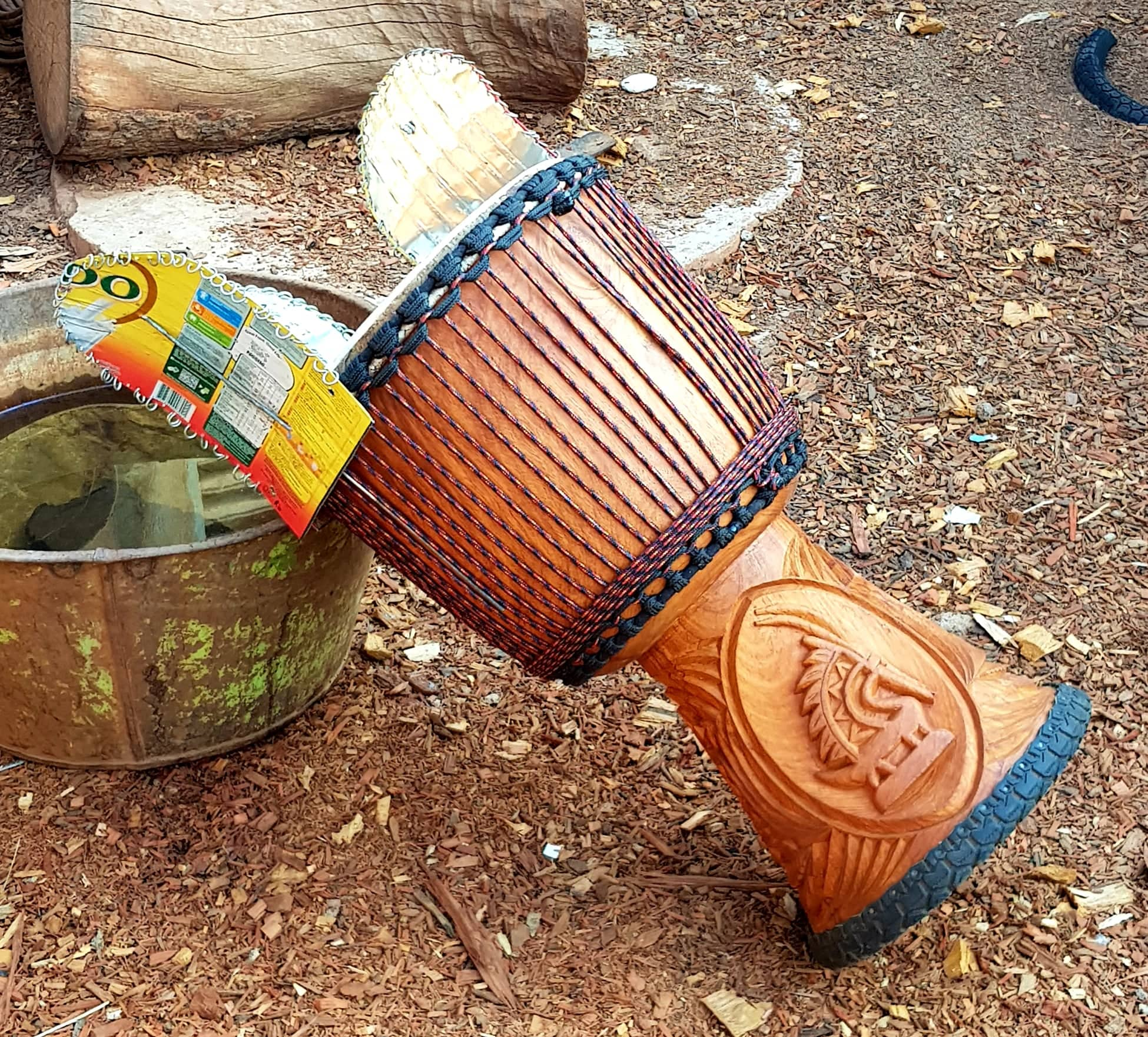Where should you buy a djembe drum? And what is the best djembe drum? Should you go to a large distributor on line, a chain store, a small company or an individual artist? This is a question often asked to me. I went on line and did a google search and was shocked what came up in the ten best lists for best djembes.
Contrary to popular google search result reports and on line advertisements, the best djembes made are not from large corporations and distributors such as Meinl, Remo, LP, Tycoon and other large companies.
So firstly we need to understand one important fact. The djembe drum is a musical instrument. It is not a toy. And it has evolved into a highly developed piece of music gear.
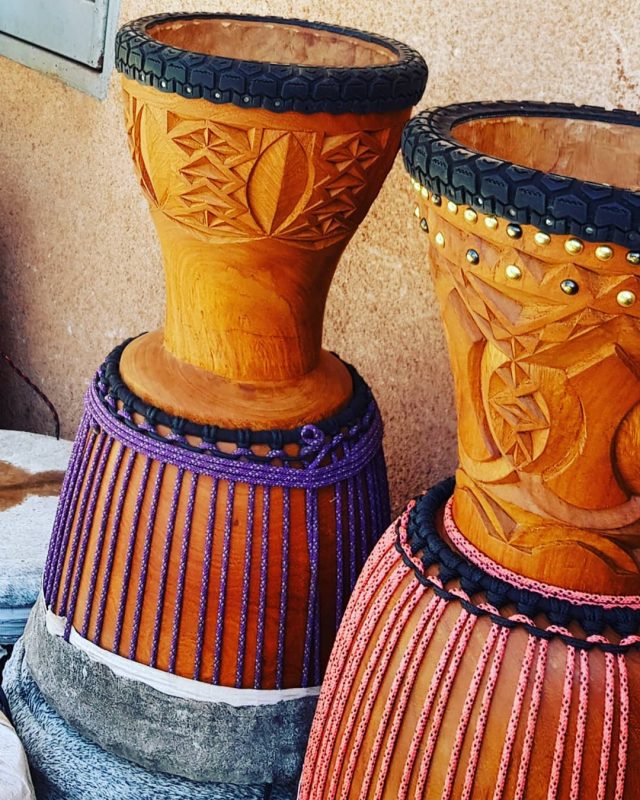
Even though they are called djembes, these synthetic and plastic offerings from the large manufacturers are very far from the true sound a real djembe is supposed to have. It is really a hybrid drum. And that’s fine, it’s just good to be clear.
The combining aspects of specific woods, thicknesses, shell to stem ratios, the size of the bowl and proportions, the type of skin, quality, even or un even thickness, age of shell and the tuning all go together to produce a specific sound in a traditional based West African sourced djembe drum that a commercial plastic, synthetic or cheap import wood djembe can not imitate or mimic.
Some people even say what the animal ate contributes to the skins quality and therefore the sound. The plastic or Remo style synthetic heads are simply not there yet in terms of matching the sound quality of animal skin or the feel. Personally they hurt my hands as there is no give at the extreme points like there is with real skin.
The skin manufacturing process as well as the shell manufacturing process is very polluting and bad for the environment as well.
You can play the hybrid drum, have fun on them and they are lightweight and sometimes relatively inexpensive and or small enough to pack into tight spaces so I understand the use of these drums. And they are great for playing in the rain or an overly humid climate.

I would argue that the Remo, Meinl and LP are not a fine musical instrument. And this is not the best sound you can get in a musical instrument. Even if you have the best technique and chops they sound bad. They are pingy and have an awful ring to them. They do not have a djembe sound.
I understand some people are against the use of animal skins as well. So this makes sense. However, you can get a beautiful sythetic headed djembe on a super nice Mali shell from Dan Rice at Motherland Muisc. And it’s going to sound a hundred times better then the large music corporations synthetic shells. Shorty Palmer will also put one together for you as well as several other independent builders.

A wooden djembe drum does have a specific sound or “voice”. When played with proper hand technique and practiced skills the drum is indeed a musical instrument that the player can “speak” on. There is a vocabulary of sounds, phrases and rhythms that are played traditional in West African djembe music where the drum originates from.
There are also rhythmic arrangements and pieces that are combined with the sister drums the dunun and sometimes other instruments to form musical compositions. The djembe is indeed a musical instrument that has taken a team of builders to put together.
At present, the amount of skill needed to craft a djembe into a professional level instrument is quite high. People have taken a lot of time developing their crafts and skills. And building a drum is a team project involving many people, not just one person.
The level of difficulty and artistry is just as high as making most other musical instruments! Special tools are need and used and there is so much involved in it that we just can’t even fathom by simply looking at a drum. There are different carvers for the inside and out, metal workers for the rings, some to pull the ropes and head the drum and so on. The tree has to be cut, wood aged, hollowed, carved. There are so many different jobs involved in the making of one drum.
In it’s professional form, when made correctly by a djembe builder/artisan it’s not, “just a drum”. It is indeed a fine musical instrument to be played by trained players. Or if you wish… untrained players, thats up to you.
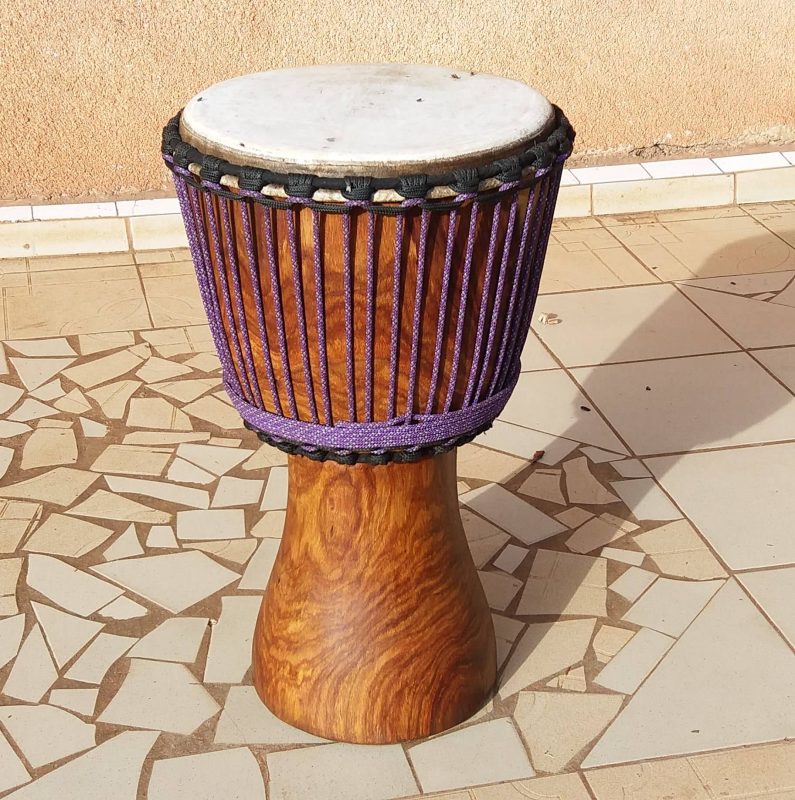
The best drum makers are very highly skilled individuals who have trained for long periods of time in the school of hard knocks.
The people like Matt Hardwick from Drumskull Drums has been honing his craft for over 20 years or more. He is constantly upping the game and improving the drum in new and exciting ways.
Wula Drum founded by Michael Markus has also been at it for a great deal of time and have been able to establish a system to insure quality and amazing sound in all of their products coming from West Africa. No easy task!
Michael Tivier of Wassoulou Percussions in Mali has also established himself and his company as a premier supplier of fine hand crafted instruments as well. He actually lives on site in Mali West Africa and oversee’s all aspects of his shops productions insuring quality control. He also uses aged wood shells.
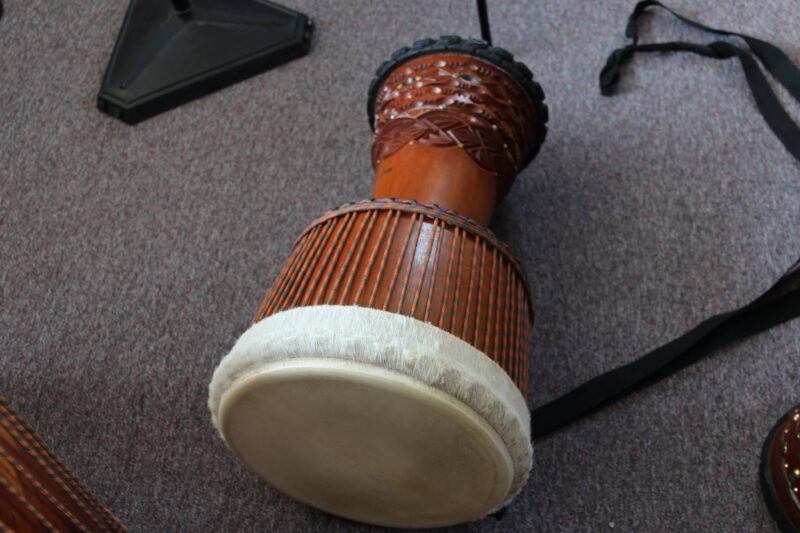
Matt Hardwick of Drumskull Drums in Santa Cruz California will be the first to tell you he is constantly learning more.
He is constantly coming up with new, creative and interesting ideas as well as leading edge innovations that help move the djembe of today up several notches in sound and beauty as well.
Every time I see one of his new drums, I drool and say, “they keep getting better and better”! I send almost all my repairs to Drumskull as they are constantly great.
Matt is also a great drummer as well and student of the legendary and incredible Abdoulye Diakate. He has painstakingly stayed with his drum making business through thick and thin. He was at the forefront of djembe development and continues to be today as well. Through thick and thin he has persevered.
I have several of his drums and I also send much of my repair work to to him. Drumskull Drums turn around time is amazing. They do incredible work and get it back to you fast! Often I am shocked at the “better then new” job they do on updating my drums, decorating them, replacing heads, oiling the drum.
And it is because of a few different companies like Drumskull Drums and Wula Drum, each with several
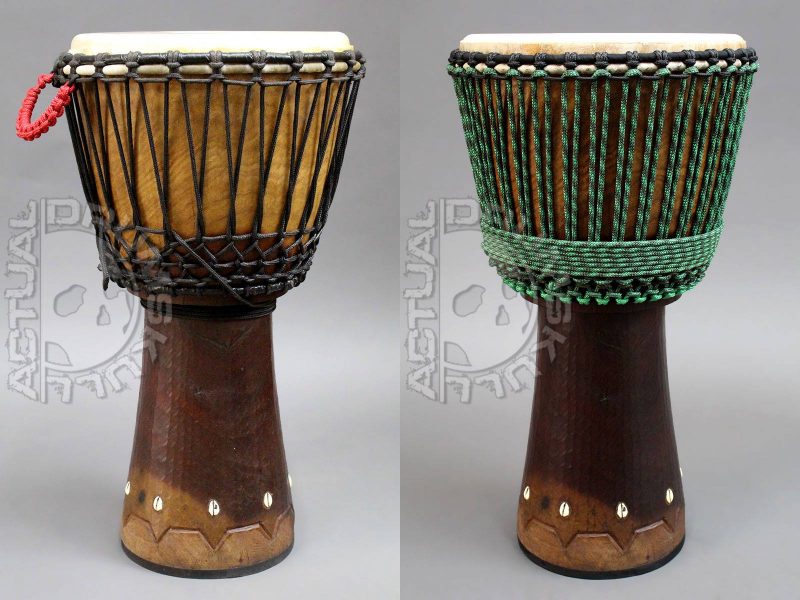
personal innovations and perserverance now and before, that a lot of us are playing much, much nicer drums and having more fun playing as well.
The sound has improved, the quality has improved and even the djembe and drum music has improved for the better.
With a better drum with a nicer bearing edge our hands are going to hurt less. With better quality skins we are going to sound better. With better rope we can tune our drums easier and the drums will stay in tune longer.
Quiet as it is kept, Matt and a few others such as Michael Markus of Wula Drum and Michael Tivier of Wassoulou Percussion have been the driving force in the improvement and advancement of the djembe drum not only in the USA but in Europe as well as West Africa itself.

Many people are not aware that advancements in the art of the djembe drum were influenced by Americans such as Chief Bey: (https://en.wikipedia.org/wiki/Chief_Bey) who brought and showed his roping system to touring artists such as the legendary and great Famadou who brought it back to their countries.
Americans were therefore influential in the development of the djembe drum you are using today. Any drum coming out of Africa from bottom level to professional has many outside sources that have effected it in positive ways.
There are now Drumskull Drums, Wassoulou Percussion and Wula Drum djembes all over the world. If it is a recent advancement, it probably happened at one of these companies first.
Everything, every product you get from Drumskull Drums and Wula Drum is a result of a tremendous amount of cumulative knowledge and experience. The djembe has evolved and will continue to do so like any other fine instrument on the planet.
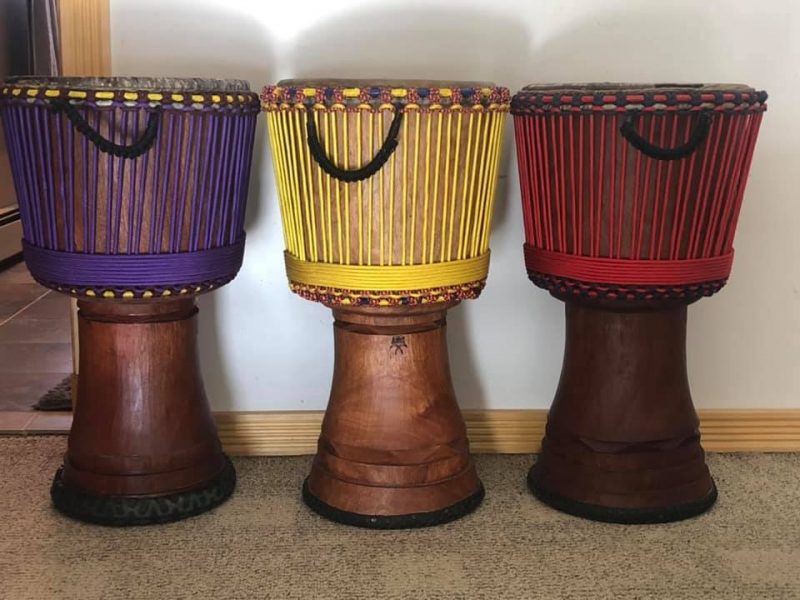
When I asked Matt Hardwick of Drumskull , “how do you get the calf or mule skin flap over so perfect? What’s the secret”? I asked because the calf, cow and mule is very hard to mount wrinkle free as it is thicker and more dense and therefore much harder to pull and work with.
Some people use heat guns, type, wired harness pulling systems, hydraulic pumps. You name it, it’s been tried and done!
But Matt said there was no secret. He does it the same way he does his goat skin drums. Skill, intention and know how. And I am assuming pulling the crap out of it! Methodology developed over years of trial and error. There is no substitute for time put in. Everyone knows that any drum they put out there is going to sound great and look great.
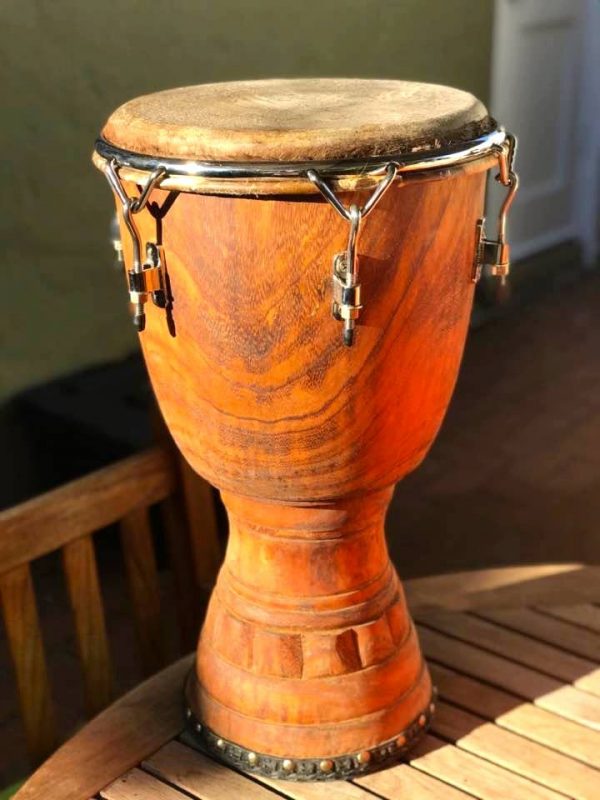
And besides the great work of Drumskull Drums and Wula Drums now, just like in any other fields of work there are some very nice new guys coming up as well.
Many people now get djembe shells from various sources originating in West Africa and then totally rework and refinish the shells, roping them and mounting the new skins on them as well.
Although this is not spoken of much the choosing of the skin, the type of skin, the thickness of the skin is part of the major function of the sound of any drum.
Matching or picking the skins qualities to balance with the tonality and frequencies of the shell itself is a fine art in and of itself. Every drum shell is different and every skin is different. No two drums will ever sound the same.
Besides the great work of Drumskull Drums, Wassoulou Percussion and Wula Drums now, just like in any other fields of work there are some very nice new guys and “independents” coming up as well.
Jason Megibow of Jason’s Djembes in Lake Worth Beach Florida is one of the fine builders who get shells from a variety of sources such as Wula, Shorty Palmer and elsewhere then “work the shells”.
This can mean anything from rounding out the bearing edge, sanding the exterior, treating and or oiling the drum and then custom building a drum to the buyers specifications. You get to pick the rope colors, type of skin, mounting method and so on.

He also has a fascinating group on Facebook called Djembe Repair where people share techniques and “secrets” of drum building. It’s an excellent resource to find help, helpers and drum repair or builders as well as maintenance tips and many other interesting things. The Facebook groups and the sharing that happens there is truly a phenomenon as things, ideas and techniques that were formerly unknown or even secret are now being shared openly.
So why buy from a small or independent company?
Here is the great thing about buying from a small company or individual craftsman or artisan. You can talk to the maker, builder or owner directly about the drum. You can discuss your needs, wants and desires and they can match or put together a drum for you to meet your needs.
Its no longer arbitrary. More often then not the drum builder or owner is an experienced player as well. This helps in the discussion of sound and general overall knowledge of what is going to be good for you.
If you have questions about what size or weight is right for you they will be able to help you as well.
I have seen charts on line for sizing and some of it is simply not right. You dont have to play a 15″ width drum if you are over 6 feet tall for example, that’s ridiculous.
A djembe drum or djembe shell does not have to originate from West Africa to sound good. There are
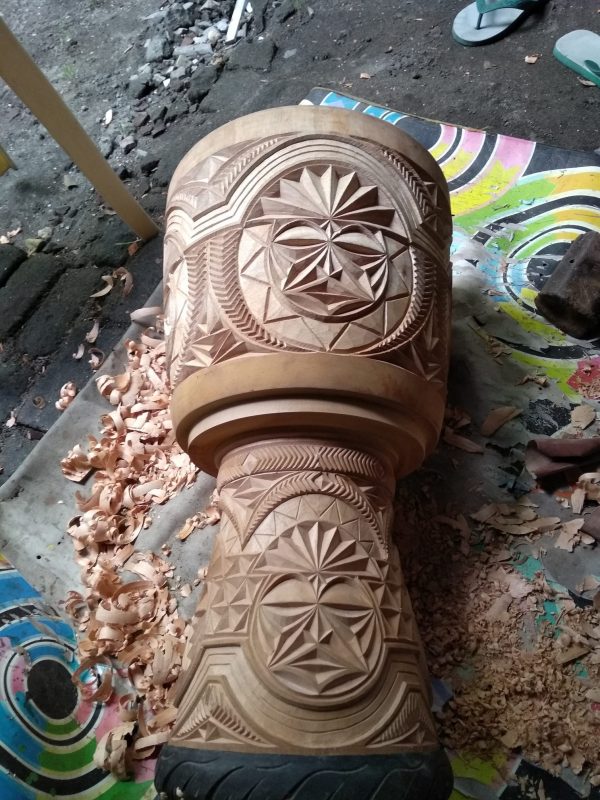
several very good people in the USA, Europe and Bali making really nice shells. I have posted several in the photos in this article and they are all on Facebook.
Arief Djembe is a master carver in Java, Indonesia. The Indonesian drums have come a long, long way.
However, beware of the cheaper drums from Indonesia! I am definitely not recommending the small cheap or inexpensive drums from there and you need to be really careful if you choose to go this route. I am not convinced they have the best skins but I have seen some amazing carved shells there.
The right skin can make almost any drum sound much better or even great. It is a huge part of the formula in your drums sound. People like John Felice of New England are taking the skin arts even further.
John will take a skin and measure it carefully for evenness. If the skin is not even thickness all the way around (which is almost always the case) he will scrape it in the thick areas with special tools to even out the thickness.
Not only does this make tuning the drum easier and more accurate, it also stops the drum from going out of round. Going out of round is more and more common from people using thicker skins and pulling tighter.
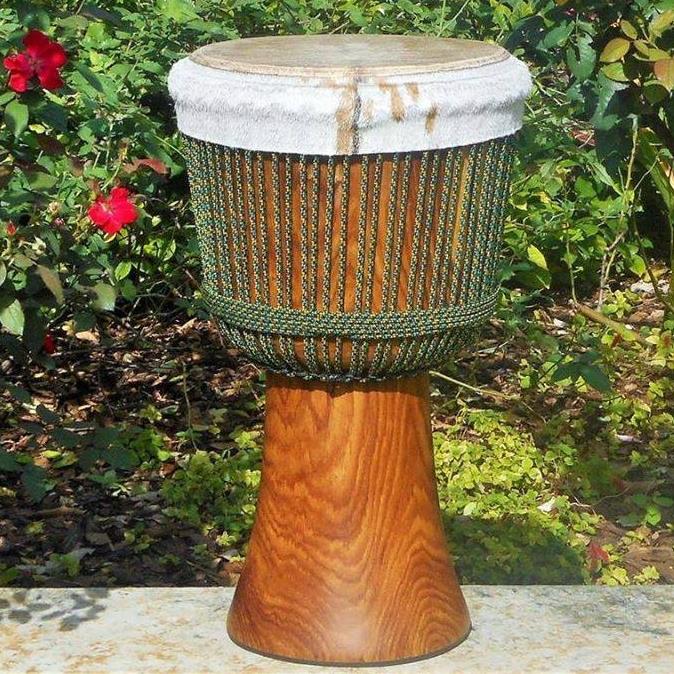
He and other independent drum builders take their time tuning them, and that is something that distributors or large manufacturers can not do. Take their time. Everything is rush rush with them.
I have visited the large companies in Bali making plastic and fiber drums and dumping chemical wastes and bi products into the nearby land. Another reason I do not recommend plastic or fiber drums.
John took a drum I had ordered directly from Guinea and did extensive work to the shell, fixing the “too thick” bearing edge and also removing almost 5 lbs of excess weight from the drum. Everyone’s first thought is, “is the shell still strong”?
I have had it for several months with a nice calf skin on it from Manito Percussion and the drum has indeed stayed in round and not been effected negatively from the weight reduction plan. I also did several sound demos on it so you can hear and compare the sound before and after.
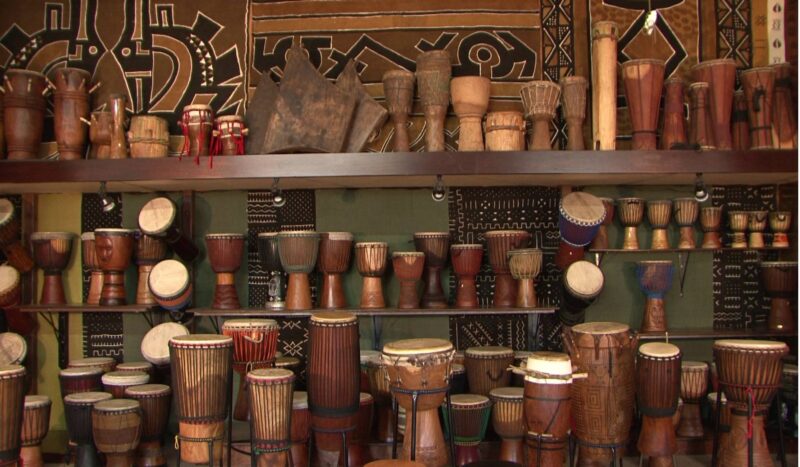
Another great person and independent shop in Southern California is Motherland Music run by Dan Rice. This a a great resource for drums, skins, accessories, repair, skins, rope and more. He has a very wide range of drums to fit any budget as well.
He has been in business since 1992 and can help with maintenance and custom drum building as well. A very knowledgable person with a great reputation and many loyal fans will back me on this.
I have seen Facebook videos of his repairs and drums and they are very good! I have also bought very nice products from him over the years including sticks and cases that I have been very happy with.
If you are looking for a drum, need a drum class or a repair I highly recommend them. For those of you against the use of animal skins Dan Rice has a beautiful Mali shell with a synthetic head roped to it as well. I have not heard it yet but it looks to be very professional made and is the nicest one I have seen.
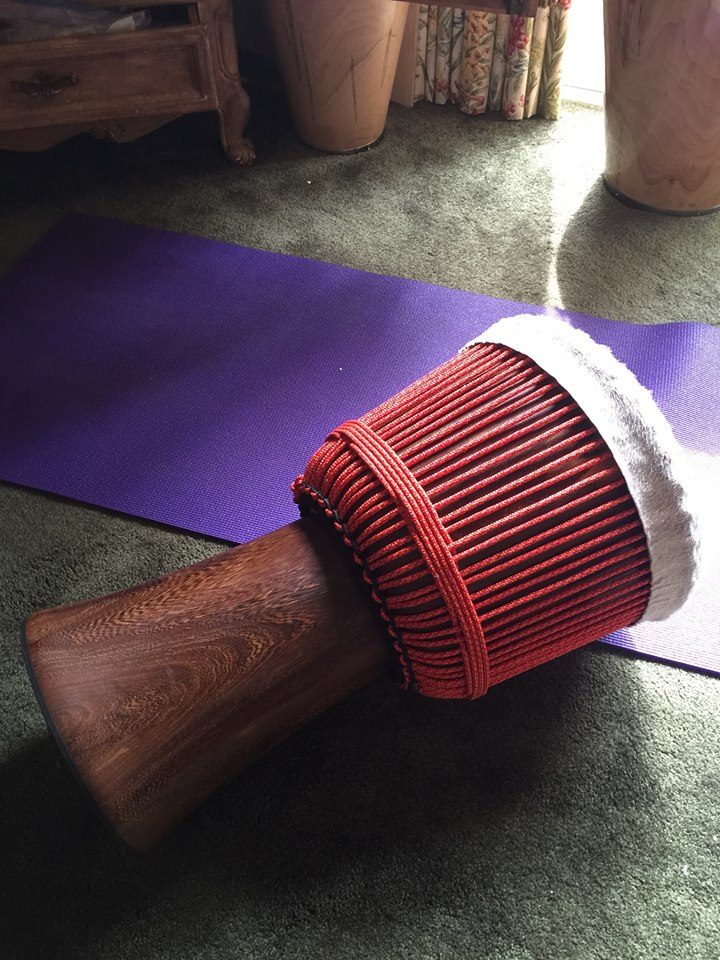
As time has gone on I have started going to more and more peoples shops to see how things are done and I am always shocked at how much work goes into building a djembe.
I don’t think most people realize this when they are buying or looking to buy a drum. Every part of the drum has been gone over and getting all the measurements perfect is another art as well.
The bearing edges on most imported djembe drums almost always need to be rounded on many of the shells specially those originating from the Ivory Coast.
Of course it depends on who is carving them and importing them as well. But on any drum from anyone you buy, you want to make sure that the bearing edge has been rounded. This makes a big difference in sound and comfort for your hands. Furthermore, the drums are often not level. You don’t want your drum leaning to the side.

Sometimes, they have to be carefully adjusted to get them even. This can be a time consuming project because any cuts made to the shell need to not only be minimum but exacting.
Therefore great care needs to be taken, you only have one chance to get some of these enhancements and corrections right. You need to have skills and tools.
When I talk about work needing to be done to the shell these are just a few of the many things that might need to be done prior to mounting the head.
Also when I talk about work needing to be done on the shells in “prep” I am not talking about the carving of the shell.
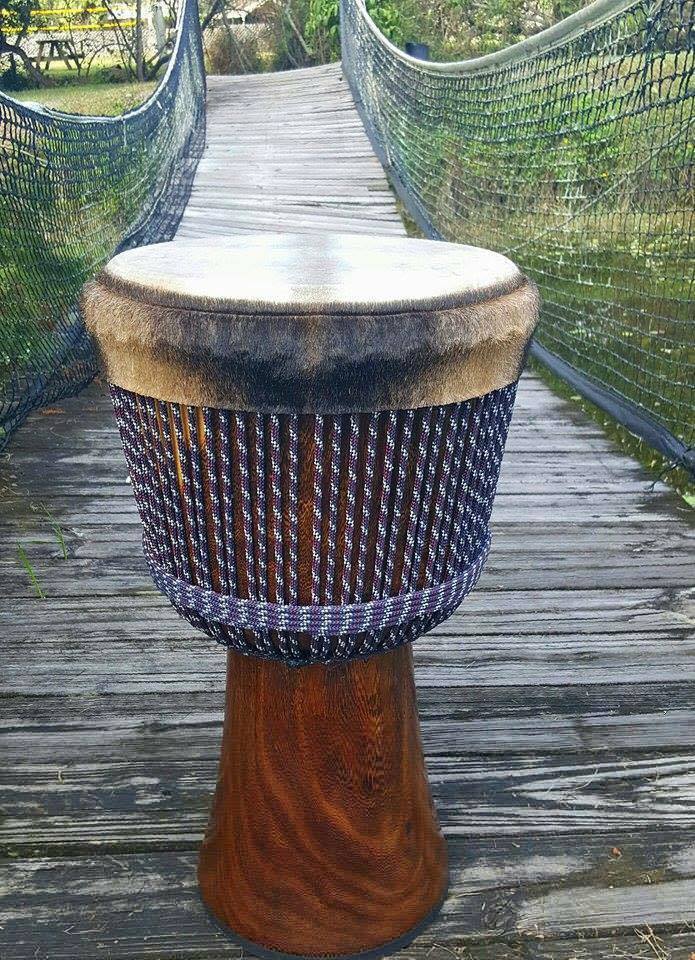
Or the work done prior in Africa. I am talking about preparing the drum, the finishing and sanding of the outside of the shell, levelling the drum (they are often uneven heights like a leaning tower), bevelling the rim (making it round), treating the wood with oil and on and on.
It is hours and hours of work! Just the prep process can take a few days. Oiling a drum is messy and if you put a few coats of boiled linseed oil on it takes a while for each individual coat to dry in the sun. If you have to sand the drum this can really take some time especially if there are carvings on the outside that have to be worked around.
Matt Hardwick sanded my MP Pro Cassia wood djembe until it got an amazing mirror gloss finish with out any chemicals, just using various different grades of sand paper. But it was a ton of work.
I love the new rubber bottoms being put on drums the last few years. Many people are gluing custom made rubber bottom rings on djembes so that no nails go into the shell.
Not only does this look superior it also stops the bottom of the drum from splitting. It also protects wooden floors from damage. I first saw this at Drumskull Drums by the way. Some people both in West Africa and also builders in the USA/Europe still prefer and use the bicycle tire. It’s a matter of preference and taste.
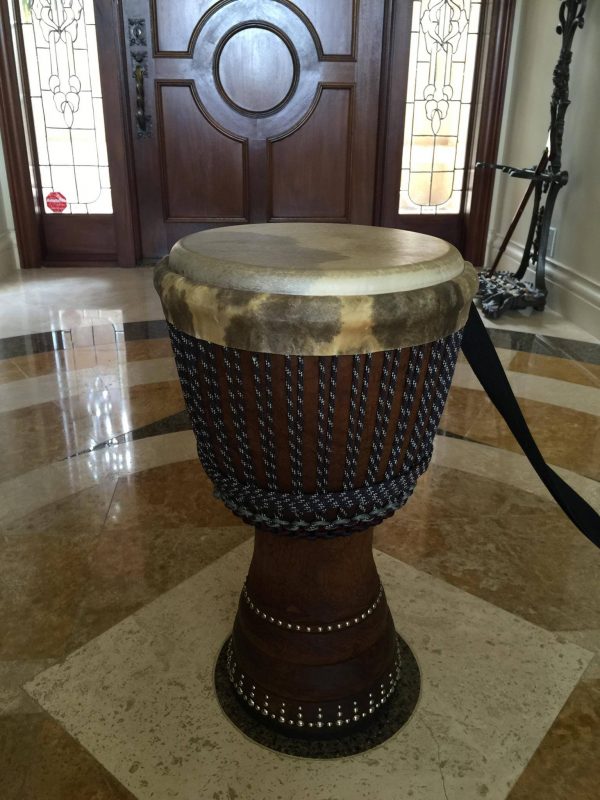
Please keep in mind that in the heading (skin mounting) process at any point, (before, during or after) a skin can pop, a flaw impossible to be seen creates a problem and all the work that was done mounting a head has to be done over again.
Hours and hours of labour. The drum maker often finishes a drum only to find a fatal flaw and has to start over. Its sad but it happens sometimes and is part of the process. This is something that you the buyer don’t pay for.
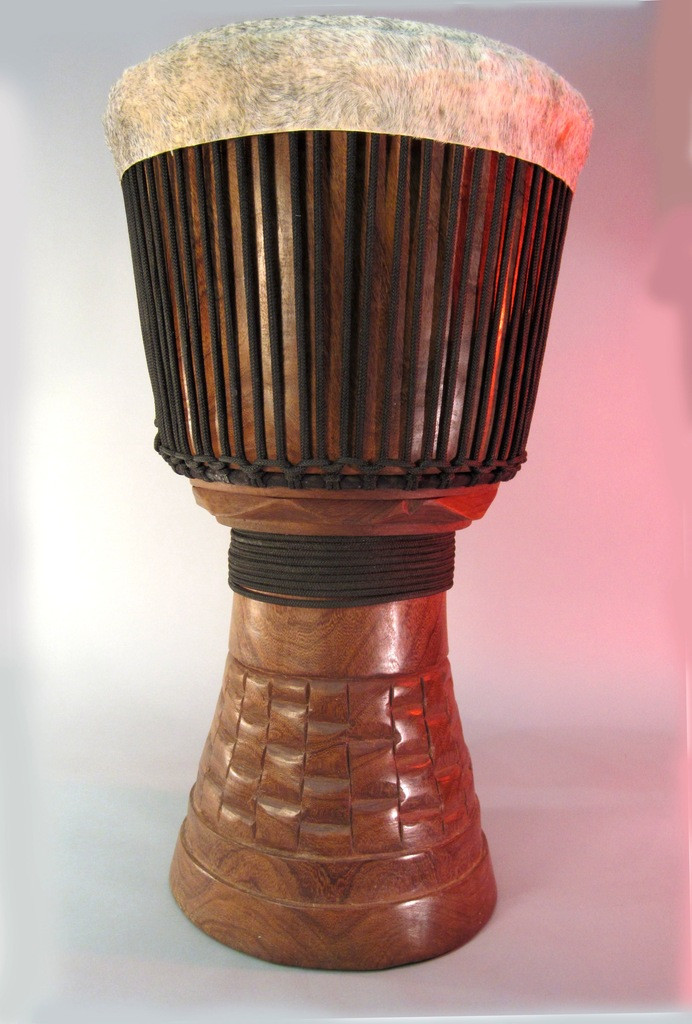
This unfortunately is something that happens to every person making a drum from beginner to advanced.
There is no getting around this and every drum maker has a story about this happening at one point or another.
A ring can bend or weld snap open for no apparent reason. Any number of things can happen. The skin can slip out. And the drum maker can not charge you for this. He or she simply has to redo the work again. Talk to any builder and they will tell you. It happens often.
It’s sad but he (or she) just has to eat the loss. The price of the skin, rope or broken ring and his or her time. It can actually take up to a couple weeks to finish a drum from start to finish including tuning it.
Many people including myself like to fully pull a drum, play it little then bring it back down by unloosening the ropes, then bring it back up again. And then repeat that process again few days later!
This is a labor of love! There are a lot of tools involved, special tools for bevelling the bearing edge to make it round (where the skin meets the drum rim) and too many others to list (or that I remember).
I understand that there are people that can put together drums much faster, but that is not my point. My point is that my friend and people like him, the artisans are indeed lovers of drums. When you buy a drum, even an African derived drum from a large on line distributor or music chain you are taking a real crap shoot.
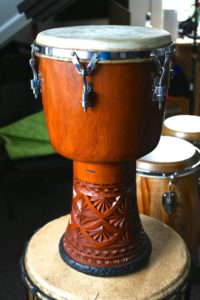
There is no way to know exactly what you will be getting. No one to talk to abut the individual drum that has played it or can play it for you. The rope quality and skin quality is not usually up to par with that of independent or artisan drum builders either. There is no way to know if the drum has been cracked and repaired with the repair covered over.
A lot of times they are less expensive but you could get much higher quality and sound by shopping around.
With some diligence and knowledge about drums you can get a much better drum then you would from a chain store or large distributor from a small company simply by shopping around, asking questions and taking your time.
Some companies such as Wula offer seconds on repaired drums or drums that are slightly out of round at amazingly reduced prices.
Just because a drum has had a repair, a crack glued or is out of round does not mean that there is anything working with it and almost all repairs if they were done properly will never come apart. Being out of round does not effect the sound at least for me.
As a matter of fact, many of my favorite drums are slightly out of round. Its just a fact of being with the amount of tension being put into drums these days and with the use of thicker skins and cow skin products.
Meanwhile the glues are so advanced these days that not only will repair not be seen (or barely visible), but you will almost never have a problem with it again.
I have never had a crack reopen on a modern djembe that was made well in the first place and repaired correctly. Wood can get splits in it and almost anything that happens on a djembe can be repaired.

I can say without hesitation and from personal knowledge and countless hours of conversations that the artisans and drum builders do their work out of love. And these “small guys” are making very little money working on a drums.
I have not met any single drum builders making a huge profit from the sale of hand made djembes. Everyone is struggling.
His or her reward is a satisfied customer.
I believe many might just barely break even yet people bust their balls over prices sometimes, which i feel are very fair in this market place.
People, all of us need to understand the djembe is indeed a musical instrument from a proud heritage and is from a culture where it is used for a variety of purposes. It is not something to be banged on. The more we all understand that is an instrument with a purpose, the more respect we have and show, the more the public will understand this as well. It is not a toy for a play shop. This misconception has to change.

Guinea djembe master Bolokada Conde also sells drums he prepares with his magical touch as does Namory Keita in Portland Maine and Mali master drummer Moussa Traore in Boston.
I am sure many other teachers I have not mentioned or know personally do the same as well.
I have had two djembe drums from Bolokada and they have been terrific and with stood the test of time.
I was able to hear them first and also to be around one of them for a period of time as Bolokada was using it as his solo drum in our performance group so I really got to know the drum. I hounded him for it until he finally sold it to me many years ago.
Namory Keita an amazing drummer and also a drum builder from the Hamanah region of Guinea West Africa also sells drums he prepares. I have one of his drums that I absolutely love. You can find them, (Namory Keita/Bolokada Conde) on Facebook or an easy google search.
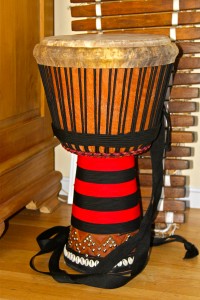
Djembe drums have changed tremendously since I first started playing in the late 1970’s.
They were very simple at first. Often un even, out of round, poor skins, bad rope and you really had to do a lot to the drum to get it to sound good.
With todays plethora of instruments on the market its hard to believe that at one time it was almost impossible to get even a half way decent drum unless you really had a great connection and even then it was hard and the drums were not nice.
However, what we got we used. Everyone contributed to drum building projects and we did the best we could. We went to local tanneries or farms to look for skins or anywhere they were available.
It’s like cars in Cuba. If it runs it is used! If it does not run, “well we make it run”! Or use it until it falls apart and then try to put it back together again. Make do with what you have. And you don’t have to have a great drum to send good and have fun, but it sure helps.
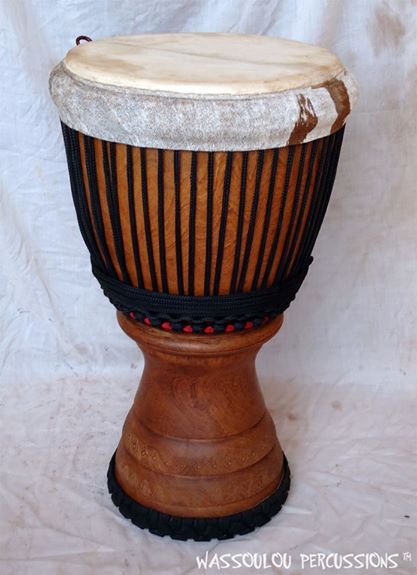
That is how it used to be and also why I appreciate the people responsible for the djembe moving forward.
It’s good to know about the history and if you have more you would like to add to this story I am always open to hearing any information you might want to add as well!
Djembe builders and artists like Matt Hardwick, Moshe, Yagbe Onilu in the Bay Area of California back in the day, and so many others having put in so much time and energy so we all have better drums to play.
And they also invented various pulling tools and instruments we use like the pulling lever made out of car parts. Or at least they brought it fourth. All of the stuff we are using and doing today started somewhere.
As I mentioned here were very limited supplies and we were happy with anything we could find. The funny thing is no one ever had a beautiful drum like today! Its a happy new djembe world we have now.
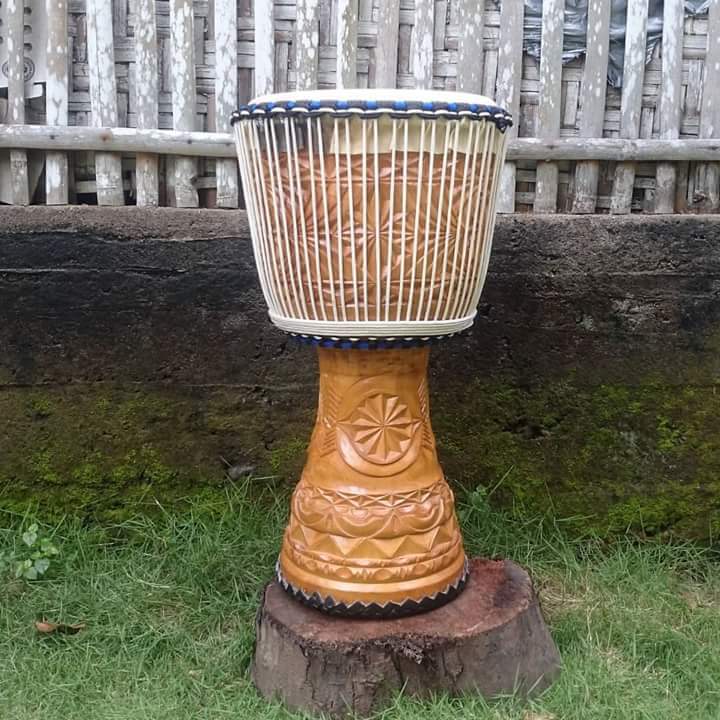
We often sourced “fresh” goat skins and suffice to say it was not pleasant. These days Manito Percussion offers after market calf skin, mule skin, goat skin and even camel skin for your djembes.
The choices are truly amazing as is the sound from these fine skins he produces. I have several YouTube comparison videos of all of these skins if you would like to check out the sound just go to my channel.
If you need a skin please contact Ryan Manito Wendel. He is dedicated to drums, drumming and drummers.
Not only a great conga player, Ryan Manito Wendel also makes many different types of conga drums, bongos and dunun (aka “djun djun”) drums from logs, from found wood and ecologically sound resources. He has some of the best skins on the market right now as well. He specializes in calf skin and mule skin for djembes as well as steer skin for conga drums.
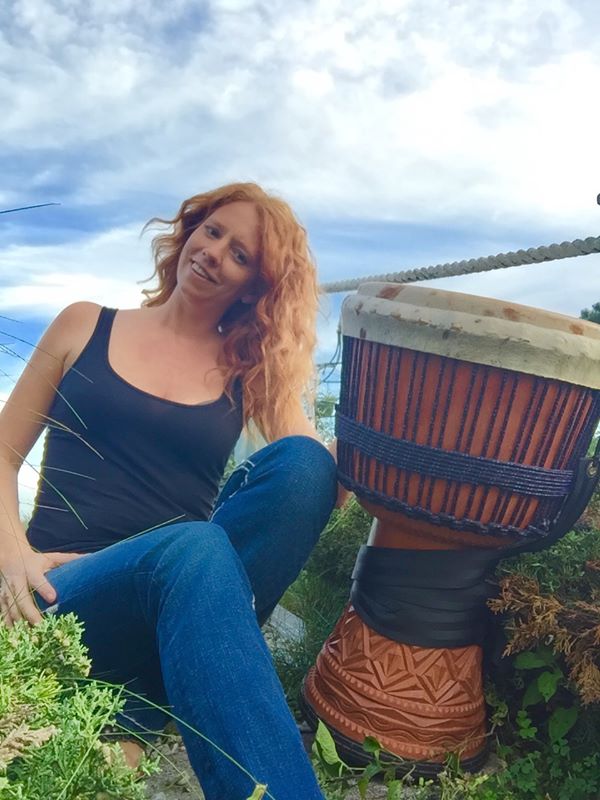
He has every type of skin imaginable. I just had a camel skin mounted on a very old shell I had. I got the skin from Manito Percussion in Georgia.
There are also a number of other resources for skins. You can check on the Facebook group, Djembe Drum or Djembe Repair for skin suppliers.
And of course the djembe builders such as Shorty Palmer, Drumskull Drums, Wula Drum, Wooden Roots (now relocated in Europe), Motherland Percussion also always have skins in stock as well as rope and other building supplies if you want to build or fix your own drum.
In the 1970’s I never in my wildest dreams imagined that we would be playing drums that looked and sounded like the drums we are talking aout and are shown in the photos here in this article.
I wish I had photos to show you of the first drums we were playing in the late 70’s and 80’s! They look primitive in comparison to the fine art that is available these days.
We sought out sources but they just were not in place yet back in the day. We are so lucky now and most of us don’t even realize that at one point none of this was here.
I am very grateful. And again we have Wula Drum and others like them to thank for setting things in place so many years ago before many of us were even thinking about drumming.
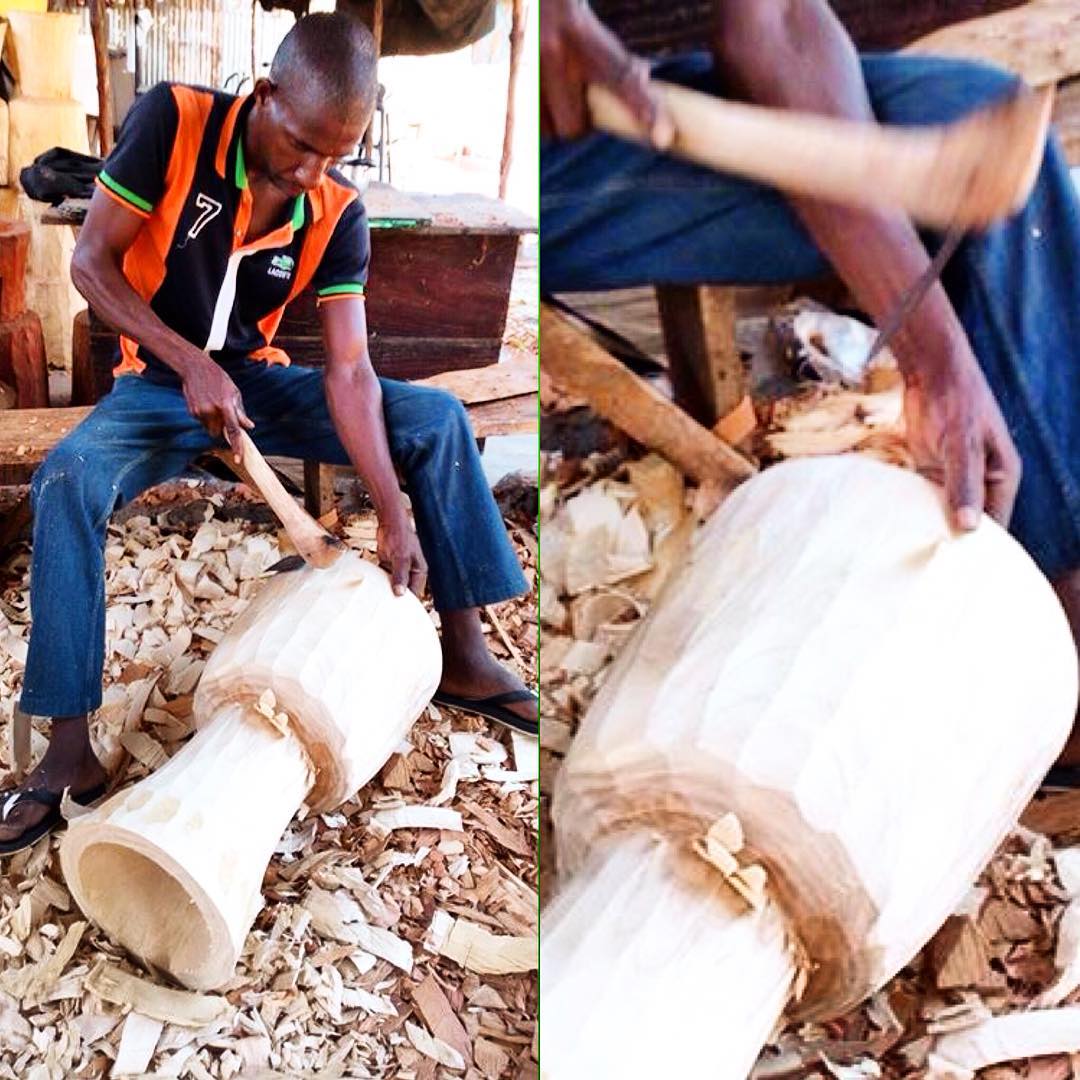
The early pioneers are why we have so much access to so many fine drums and related gear today. They found the resources, open the doors and started the process.
At first it was hard to get shipments and to work things out but gradually over time they got it together and established the groundwork and set things up for us.
There was no internet in those days and it was all who you knew, who might be taking a trip to Africa and building your own gear which some of us did to various degrees of success and failure.
And now fast forward to 2019 and the drums have really advanced. The craft and the shell itself are now made to exacting standards. The shells may have ornate detail, carvings, bling (tack work, metal work, studs, tacks, pins and/or all kinds of misc. decorations). The sky is the limit. And it gets more and more interesting every day. People are sharing techniques, styles and experimenting. And it’s all for the better.

My friend Djembe Thunder, a djembe drum master from Mali now living in the UK is making awesome djembes and decorations like I have never seen before with interesting metal work and wood colourations. He also uses antelope skin which i have not tried before.
Although I am a fan of the plain shell with out carvings I do appreciate the great art of decorating djembes. Interestingly enough I am told that drum maker Tom Kondas, (formerly of Wula) had great influence in bringing special carving tools to Guinea to do “chip carving” which they had not done much of prior.
Wula Drum headed by legendary drummer Michael Markus has a dedicated team of drum builders in Guinea, West Africa. They work very hard every season to provide the highest-quality instruments using the best possible materials. Their djembes are sourced from the hardwoods in Guinea: Lengue, Khadi, Acajou, Doukie, Koula Koula, as well as Melina Wood for their lighter drums.
The Special Piece is their top djembe model, made from the best wood selection of the season. Each Special Piece drum is a unique work of art, handcrafted and assembled by Wula Drum’s master carvers at their shop in Guinea. Wula Drum’s unique step design keeps rings snug for superb tuning, and helps to create the legendary Wula Drum sound. I have and play a Wula 13″ Lenke drum with thick goat that is not only beautiful but does indeed have that has superb sound.
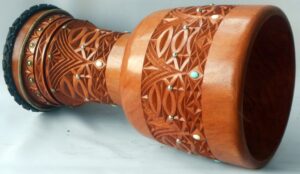
So as you can see here there are several small grass roots companies that specialize in djembes such as Wula Drum.
They have taken the art of drum building to a new level. Every time I see a new post from these companies and also the individual artists mentioned it is very exciting for me as the art and craft continues to grow and expand.
The beauty of the drum is really coming into play and the selection of ropes and choices is mind boggling as well. You can custom order your own drum and you can even have your own djembe design implemented by Wula Drum if you like (and don’t mind waiting on a special order djembe).
I would like to point out a very interesting difference in the djembe and conga drum world here. In the conga drum world, if you order a hand made drum there can be waits of anywhere from 6 months (minimum) to several years! There are people waiting over 2-3 years for certain artists drums. We are very lucky in the djembe world to have these artists and small companies like Wula Drum , Shorty Palmer and Motherland Percussion who invest out of pocket so you don’t have to wait!
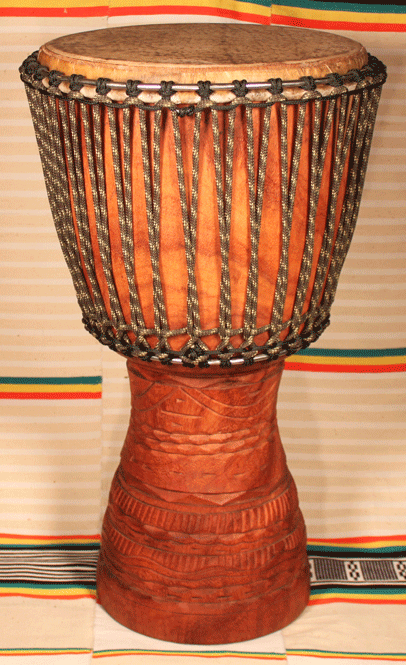
These companies and artists have single-handedly pushed things forward in a good way! Everything is better now then it was when I first started. The art of drum making has improved enormously.
And my point is this. The djembe you are now playing that you might think is 100% West African has been influenced and co developed by Americans, but even the rope used is not from West Africa. It is now a joint effort!
Wula Drum has led the way and everyone else followed. Many interesting innovations I have personally seen or experienced came through them first. If you know your drums then you will know about Wula Drums and the history of the djembe in USA .
I have seen several mule skins put on beautifully, but not any flap overs with out wrinkles. It is not necessary to have a flap over skin by the way, it is just my personal preference.
Meanwhile, the ropes these days are not only more beautiful but much stronger then before. The shells themselves are amazing art pieces. There are woods available that I have not even head of until recent years.
Carvings have evolved to masterpieces and it keeps on amazing me more and more. Wula Drum leads the fore front in artistic carvings and have museum quality pieces that are quite stunning. Some of their drums would look great with out any skin sitting on your shelf!
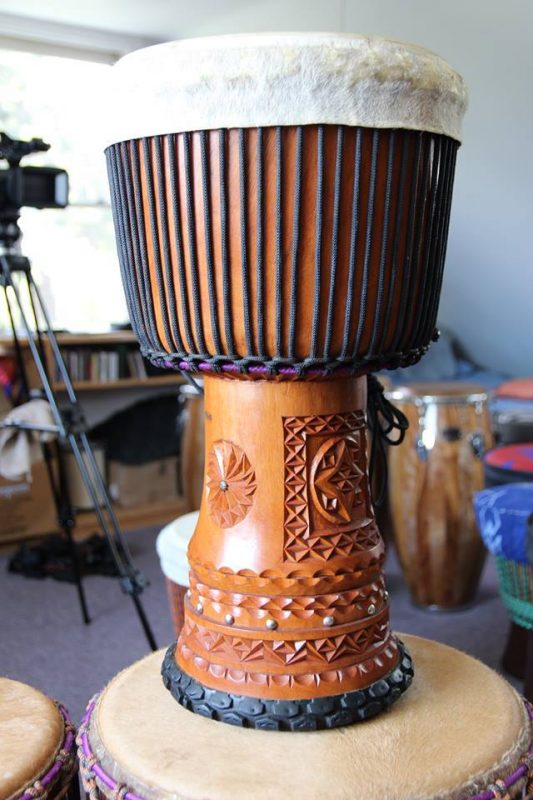
The carvings in the djembe drums just keep getting better and better (if you like that sort of thing). Personally I prefer a drum with no carvings but that is just my thing. .
Many people have helped both in West Africa and the USA and the quality has benefitted for all of us as well as the sound. Large efforts for reforestation also have been made. It is a long and on going process. Wula Drum has started a re forestation project as well in GUinea recently/
So the djembe keeps evolving and, (in it’s professional form) is now a very fine musical instrument like any other instrument.
Just like a fine high end guitar, violin or piano. Some of us including myself, got stuck on never paying more then $350 for a djembe until recently. I thought the sellers were out of their minds selling a drum for $500 a few years ago. I vowed to never pay more then $350 but that changed!
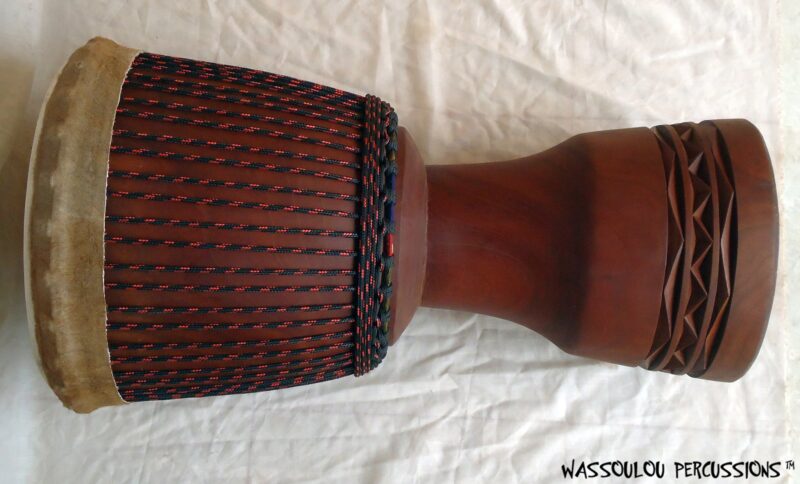
Who can afford that? Recently I saw $1200 drum get sold very fast. I was shocked at first. But before you say, “I can’t afford it that’s too much”, “they are out of their minds” or anything else like that I want to say that I now understand about the tremendous amount of time and energy that goes into making these fine instruments.
I am not writing this article to justify anything. It is only to explain that a fine musical instrument hand crafted from wood with an intense amount of work put into it to me is worth waiting for.
Save up and get your self a righteous instrument. Sell your house, car, whatever. Don’t get into the mindset some people have that “it’s only a drum”. It is an amazing healing and musical tool for you to make magic on.
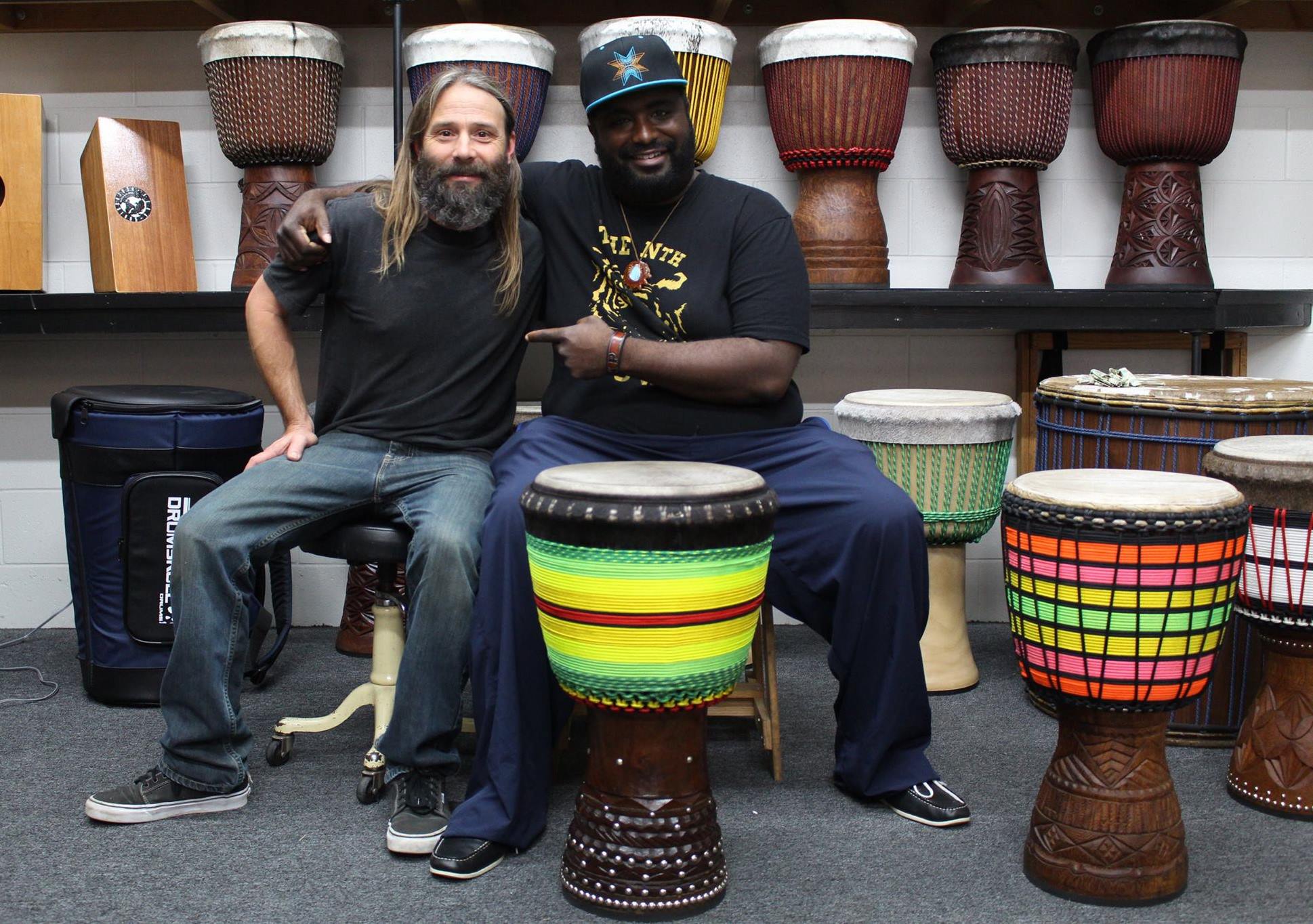
I truly believe that that drum that sold for $1200 is worth every penny, and that it was not a big profit maker. The amount of work that goes into the drum, the carvings, the glued rubber bottom, the extended triple hitches. There is a lot of stuff going on and a lot more work involved then there used to be!
I am not saying I need that drum, or you need that drum. I am saying it is a finely crafted musical instrument, like any other high end exquisite musical instrument of any type. Great is great! And we can’t take that away from it.
When you order a fine djembe drum from any of these sources or builders you are paying for the best sounding, best looking and highest quality and you get what you pay for it. As I mentioned, no one is getting rich from it and as you have read here so much time and effort has been put into your drum by a team of people.
These djembe drums are going to last a lifetime and are a super high quality product. A piece of art and a wonderful sounding easy to play musical instruments as well.
Beautiful, powerful drums are now within everyone’s reach and all we need is the cash and of course the know how to play them! But that is another story completely. Do we need these fine high end drums? Can’t we just get by on the simplest possible drums?
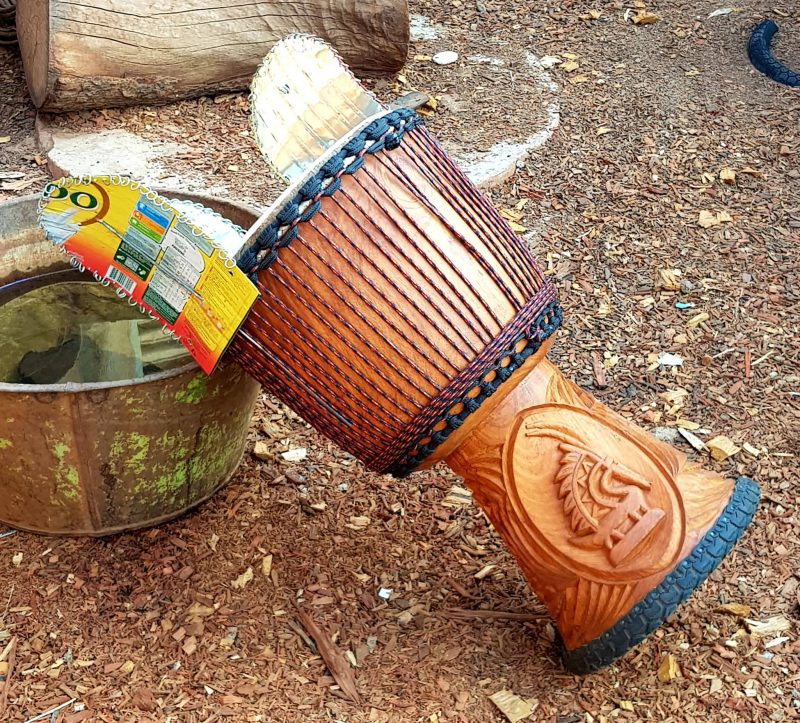
I don’t think we necessarily need to have or own a highly decorated drum as outside carvings have nothing to do with sound. But as a visual artist I do appreciate a well decorated or carved drum.
For me a plain simple stem is fine. I even have an ugly drum called Igor that was made way back before the beautiful carvings started. The wood is aged now and it sounds great.
The important things is that the djembe drum has the correct bowl to stem ratio, even wall thickness, a resonant wood type, the proper size and weight .
There are woods out there that simply don’t sound as good as the other woods. I am not a fan of Tweenaboa wood, the super light wood used in most of the Ghana export drums.
I have however heard some with cow skin on it that sound good. I have not heard any with goat that have sounded great though. On the other hand I have heard many Melina wood light weight djembes sound fantastic. Both Drumskull and Wula Drum sell Melian wood djembes. They are much lighter then the hard wood drums and also more sustainable in terms of the ecology.
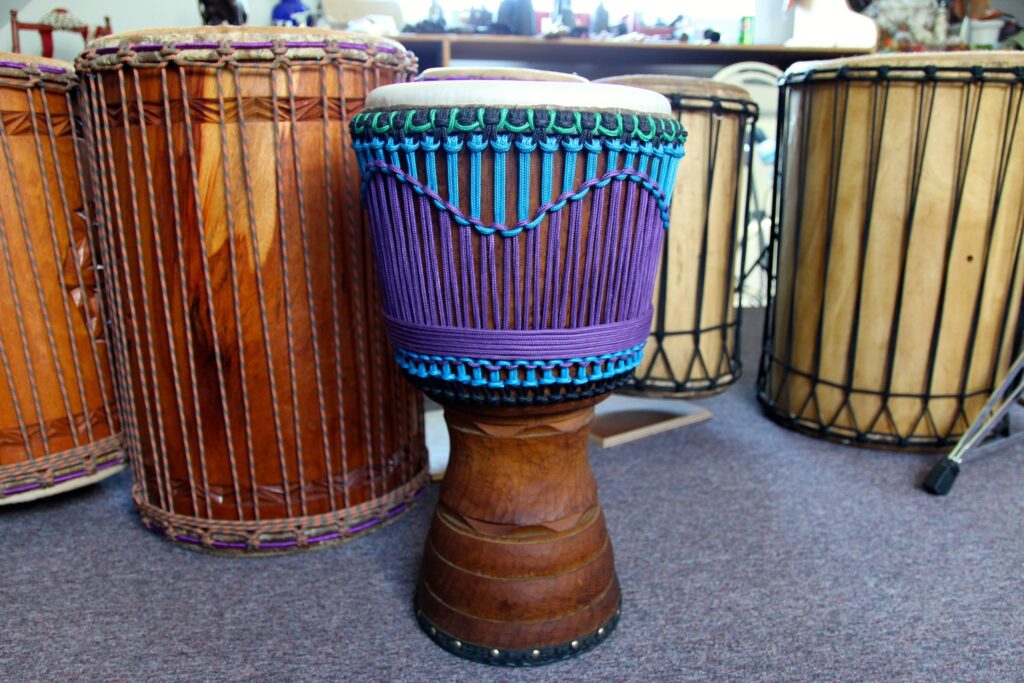
Something I hear all the time is , “it’s not the drum it’s the drummer”. And to be perfectly honest I often say, “Its all about your technique, a good player can make anything sound good, it’s not the hammer it’s carpenter (yawn), its not the arrow its the person shooting it”.
And this is true. Bolokada Conde can make a garbage can sound terrific. But even he is going to sound way better on a great drum then a cheap drum. And a great , well made drum with proper skin is going to be easier to play on as well.
To recap, a professional level drum is made professionaly. A professional level player can play it and at the same time a beginner can play it as well. Not only that, a beginner is going to have a much easier time playing a good drum then a cheap drum. I routinely bring extra drums to my classes as people often show up with tiny, cheap crappy drums. I want them to hear the difference.
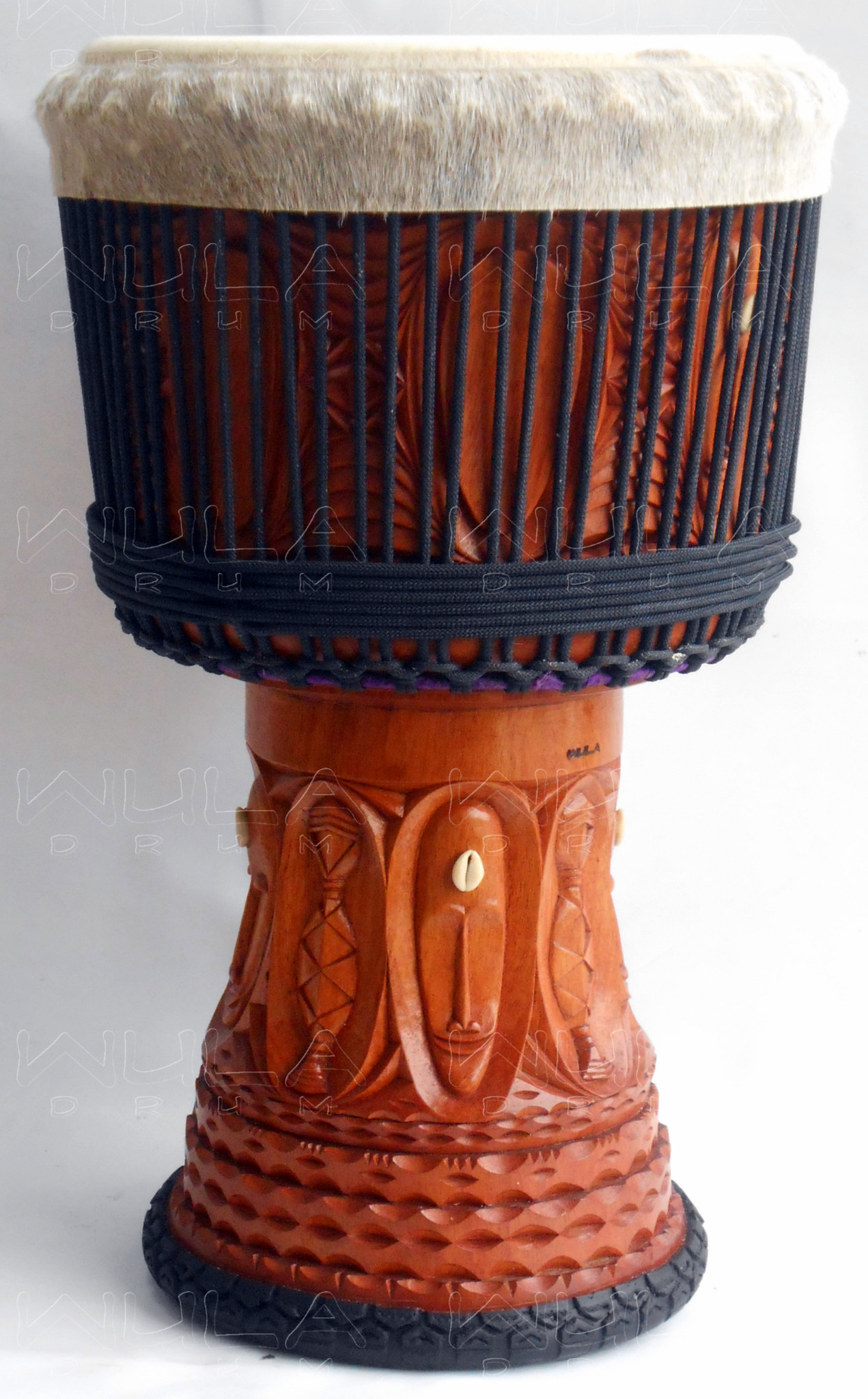
A great drummer will sound better on a great drum like Wula, Drumskull, Wassoulou and the many others mentioned. And together, a skilled player on a beautiful carved djembe is a wonderful thing to see, hear and experience!
And more importantly to you and me, a beginning or intermediate level drummer is going to have an easier time to learn on a well made djembe drum that is easy to play, the correct and large enough size and that has a good head on it properly pulled and tight enough.
It sounds amazing, it looks amazing and it is a highly developed and refined product. It’s the best of the best. Think Stradivarius. So, for me, it is worth waiting until I have the money to buy a great instrument rather then compromising and buying an inferior product.
A Martin guitar can be $25,000. We are going to be seeing more and more beautiful djembes and the prices are going up. But before you go out and buy a new drum, check your skin. More often then not, the right skin can make all the difference in the world.
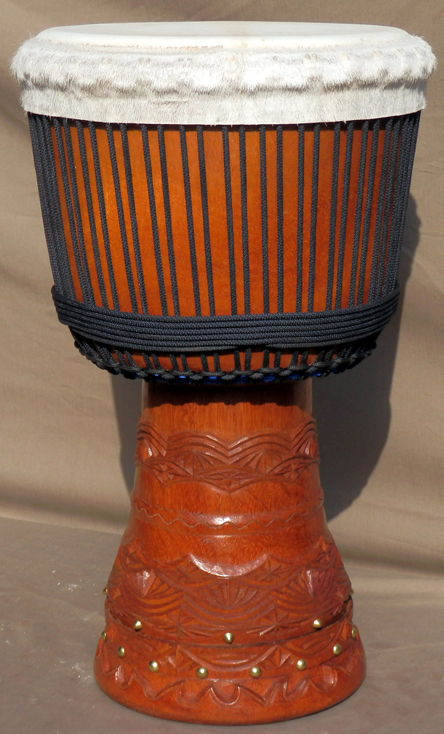
I am not saying we all need to buy $800, $900 or $1200 drums, but a drum for $500-$800 from an individual craftsman based on the amount of work he or she has put in to it is not too much money in my opinion.
I once said I would never pay over $350 for a djembe and for many years this held true but then I caved in when I saw the constant beauty and superior sound that others were getting with the higher end drums. I had to (happily) eat my words!
So please don’t bust these guys chops over prices. They have expenses and hardly anyone is making a living off of selling high end drums. The cheap drums are indeed cheap.
If you buy a cheap Remo or Meinl style non authentic djembe drum and you learn how to play, eventually you will get tired of it. And so will everyone around you! It happens to everyone, me included. There is a lot of crap out there and be sure about what you are buying!
If you do need a tunable drum, a Wula Drum “Ropeless” djembe or Manito Percussion djembe with tunable metal hardware is a very nice alternative. Some people live in areas where they can not get help if a skin pops or maybe you are a performer on the road and dont have time to change a skin that pops.
If this is the case these drums are a viable alternative as you can simply tune the drum with a wrench

and also buy the drum with remounted extra heads. If the skin rips or pops you can simply change out the head and be up and running in less then 5 minutes rather then a week waiting for drying and pulling.
One point I would like to make about going to an individual to hand craft your drum is that you get to be involved in the process, (if you like) and you get to help design your own drum. These guys answer their phones, you can talk through stuff.
You make the choices. The ropes, the rings, the skin. Rubber bottom? The type of head job. You also get personal service. It develops a connection between you and your drum as well.
With individual builders I know in the USA, you pick out the shell and you tell him what you want and he makes it for you. If it does not come out right he changes stuff.
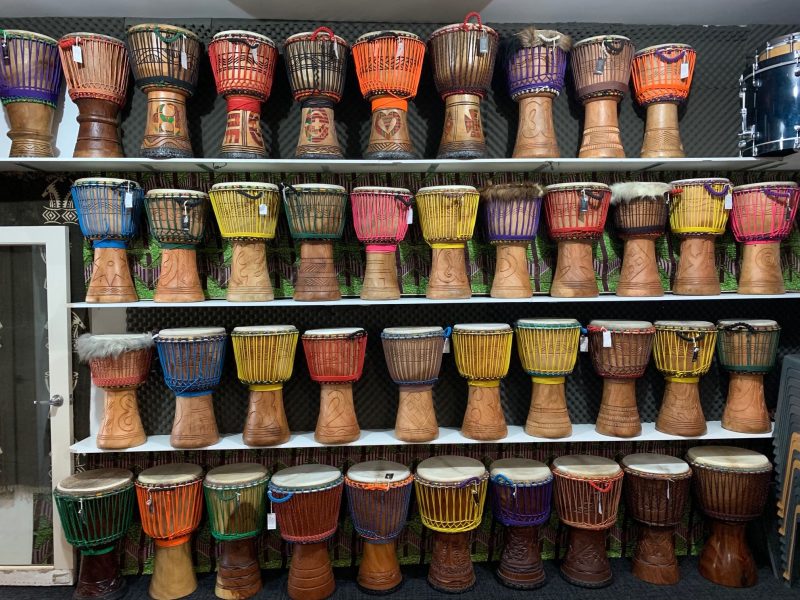
What I am saying is that you are now involved in the process, it is more personal and it’s not simply a “here’s the money give me the drum” thing. It can be if you want that and that’s fine.
But the people hereI have mentioned and also those in the photos are going to make sure it is done right and you are happy. They are not churning out drums in a factory.
There are many many individuals making and selling djembes and I can only speak for the people I have dealt with personally so you will have to do your own diligence.
My recommendation is to get involved with your drum purchase by using an individual artisan djembe builder. There are several individuals I can recommend who do great work putting together djembes one drum at a time, made to order. You can discuss your needs and work out the best drum for you.
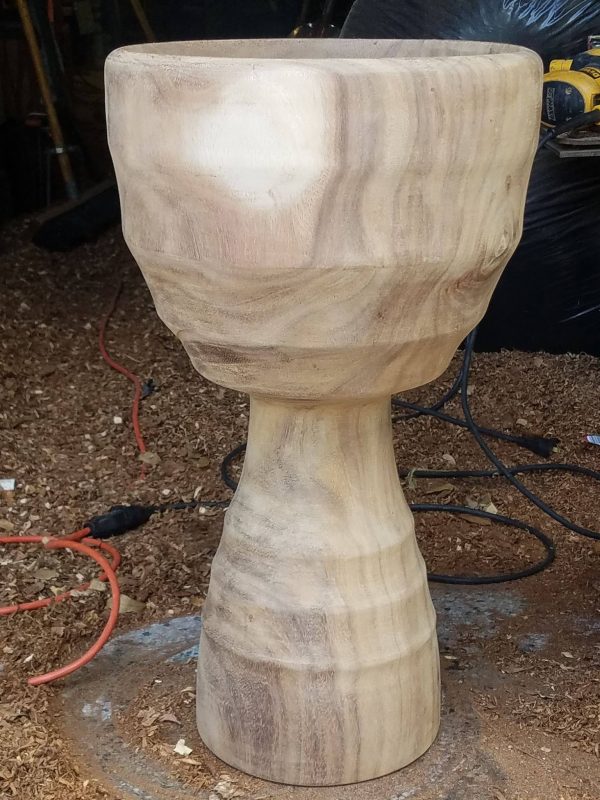
Not too long ago I heard then asked to play a drum made by Bezl Labonte at a drum jam I was at. The shell did not look like a typical shell. Please check out the photos here in the article.
It had a cow or calf skin on it. I was shocked how good it sounded despite not having what has become standard, look, size or shaping in modern djembe drums. So I ordered one. Mine is made out of a local wood called Elephant ear.
The drum has a lot of tone, bass and sharp slap and really projects. Its not a typical drum or “classic” sound but perfect for cutting through large groups of people while maintaining a musicality in its tone and bass.
If you are looking for a perfect jam drum or drum for drum circles it might be it because it is also quite light so hiking in with on your back is not bad and you can where it easily as well.
Jason Megibow of Jason’s Djembes in South Florida, Nate Vellinga in Colorado and James Mack in Australia are just a few of the very skilled independent drum builders out there today. There are many others, you can look on Facebook in the Djembe Repair group to find someone in your area that puts together drums as well.
Shorty Palmer (Goat Skin Dreams) by the way, is an excellent source for inexpensive shells usually from
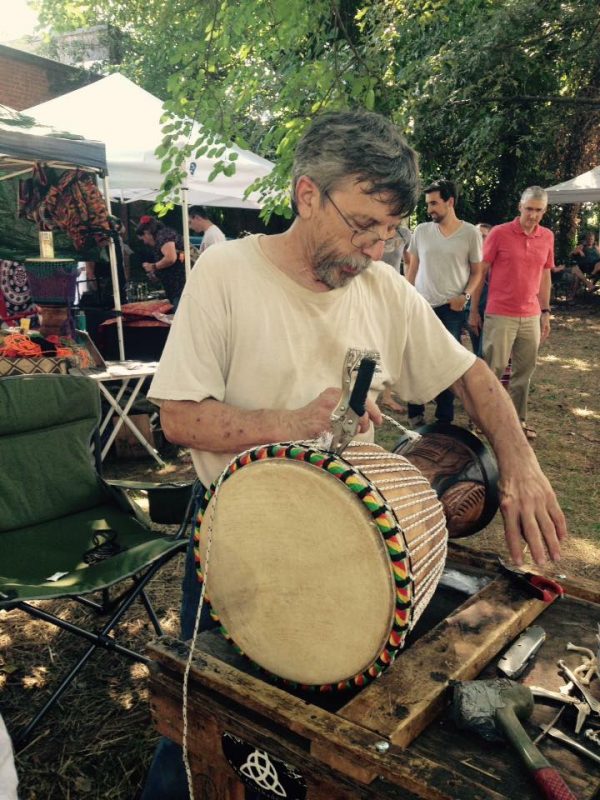
the Ivory Coast. With some hard work and elbow grease these shells often turn into real beauties. He can put together a nice drum for you if you are on a strict budget.
He also has a large variety of skins, (I am told he is the largest skin importer in the country) and building equipment such as pulling tables and is a great source for information on how to put together drums.
And last but not least he has inexpensive real drums from West Africa in all shapes and sizes. He can get you a lightweight drum that sounds good, too.

Michael Tivier of Wassoulou Percussions lives on location in Mali and oversees all aspects of production in his West African djembe and dunun drum company.
He uses aged wood shells, many of them 7-10 years old. He is very focused on quality not quantity.
I personally prefer aged wood as this is something very special indeed. Great craftsmanship in all his drums and very nice attention to detail. He can drop ship directly to you from Mali as well.
I am looking forward to trying one of his drums soon!
Also, please check out his videos on Facebook and Youtube of his children playing drums in Mali. They are wonderful!
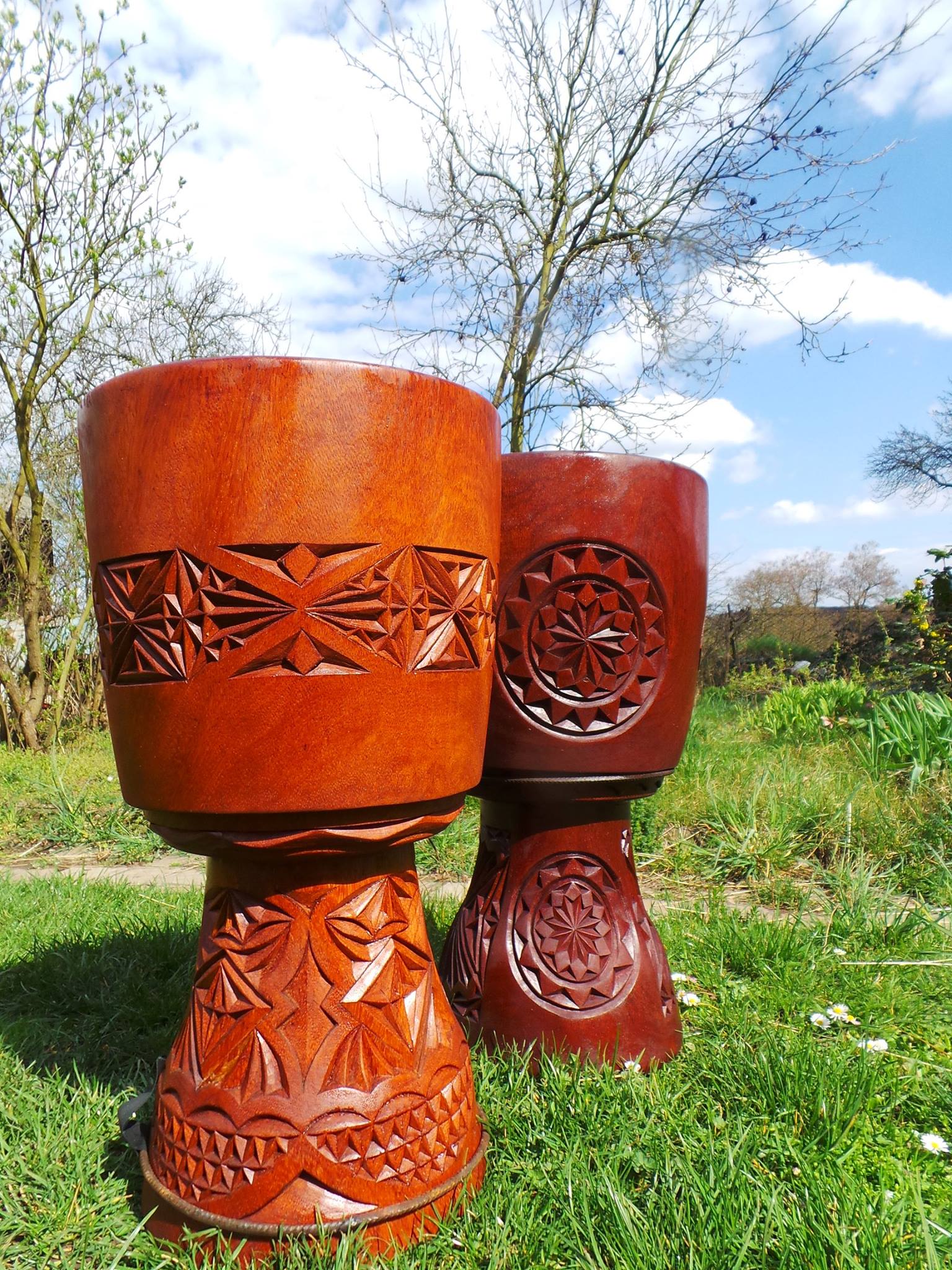
AWA and The Mamady Keita signature series drums are made very nicely as well. I am not sure if you are paying a little bit more for the name, you will have to decide that but they are made beautifully.
Timothy Dabrowski of Drum In The Sun Drum And Dance Retreat on Koh Phangan Island in Thailand puts in a staunch effort on every djembe I have seen him put together and uses unique Mongolian extra thick goat skin from China as well as Pakistan and West African skins.
If you are on your way through Asia he is a “must see” kind of guy I highly recommend for djembe sales, repairs and drum lessons
Please keep in mind almost all of the people, shops and companies I am mentioning have budget models available at low prices, one way or another.
Wula Drum has a line of drums made from a sustainable wood called Melina wood which are not only light weight but they have great sound and the are much less expensive then most other drums. Wula has several different models as does Drumskull Drums.
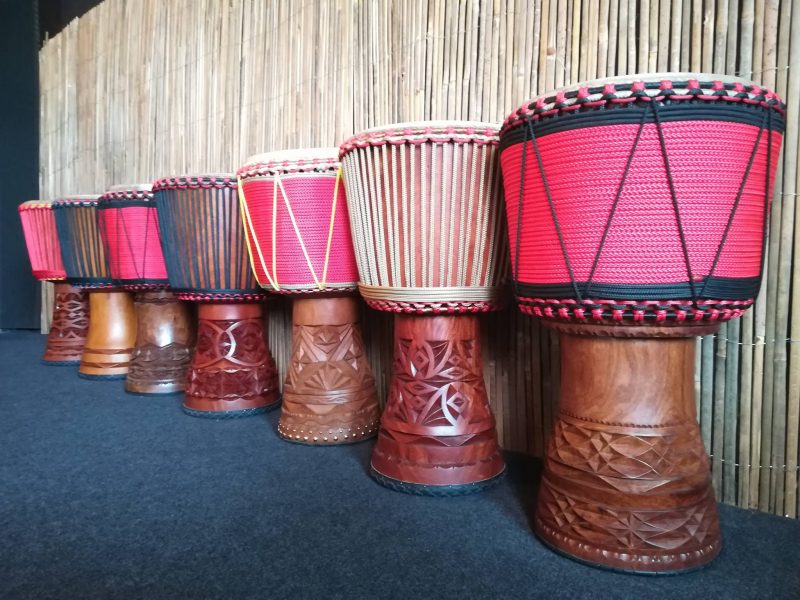
If weight is an issue and you want to play standing up think about playing your drum in a portable collapsible stand. I have both metal stands as well as wood. The metal is much stronger and supportive for my heavy handed playing style.
If carrying your drum around is an issue please get a portable lightweight collapsable cart. I have one and I can get 2 djembes, my stand and 2 seats in it. You can also put your backpack and snacks water, etc. in there to and have your own little station so to speak.
I unpack it from the back of my car and I can roll it to any jam, gig and even on to the beach. So there is no need to compromise your sound as long as you do not mind pulling a cart around a little bit. Its a great way to go and wish I had been using one years earlier.
So where do we find an independent artisan or drum builder? Unfortunately I can not list all the

independent artists and people making drums, there are simply too many. Especially drums I have not played, so please do not write me and tell me I forgot someone, if I did not mention them its because I am not familiar with them.
If you would like to mention someone you have had positive experiences with in the comments section that is a good place to do it.
Facebook groups such as “Djembes For Sale”, “Congas And Djembes For Sale”, “Djembe Drum”, “Handmade Djembes And Congas” are excellent resources for finding new, established and interesting djembes made by master carftmen and artisans alike.
You can read other peoples comments and reviews and interact with other drummers or drum makers in positive ways.
People are almost always supportive at least in the groups I just mentioned and it is a great way to ask and get questions answered by (generally) knowledgable people.

Thanks to the internet and open minded individuals information that was once top secret or unavailable is now being shared openly and it is easy to learn how to put together drums if you are handy and would like to try it your self.
I see more and more new companies popping up everyday and I have not researched european companies of which there are many as well.
I am happy to hear from you or from the other artists about their drums and would love to see photos, videos and info too!
Please send it in! I will post it if it looks good. It is so nice to see and it is the diversity and influx of new and creative ideas that keeps this exciting art form moving forward.
I personally enjoy all the new styles, creations and learning about the individuals and their craft, their ideas on the internet. Because of the internet and open minded people many new and interesting ideas are shared freely and people in far away places that dont even speak the same language can see the photos and get ideas how to improve their drums from afar.
When I am in Thailand I see several innovations in the local small drummers communities that came directly from Jasons Djembes and his Facebook groups. In Malaysia I saw Shorty Palmers products!
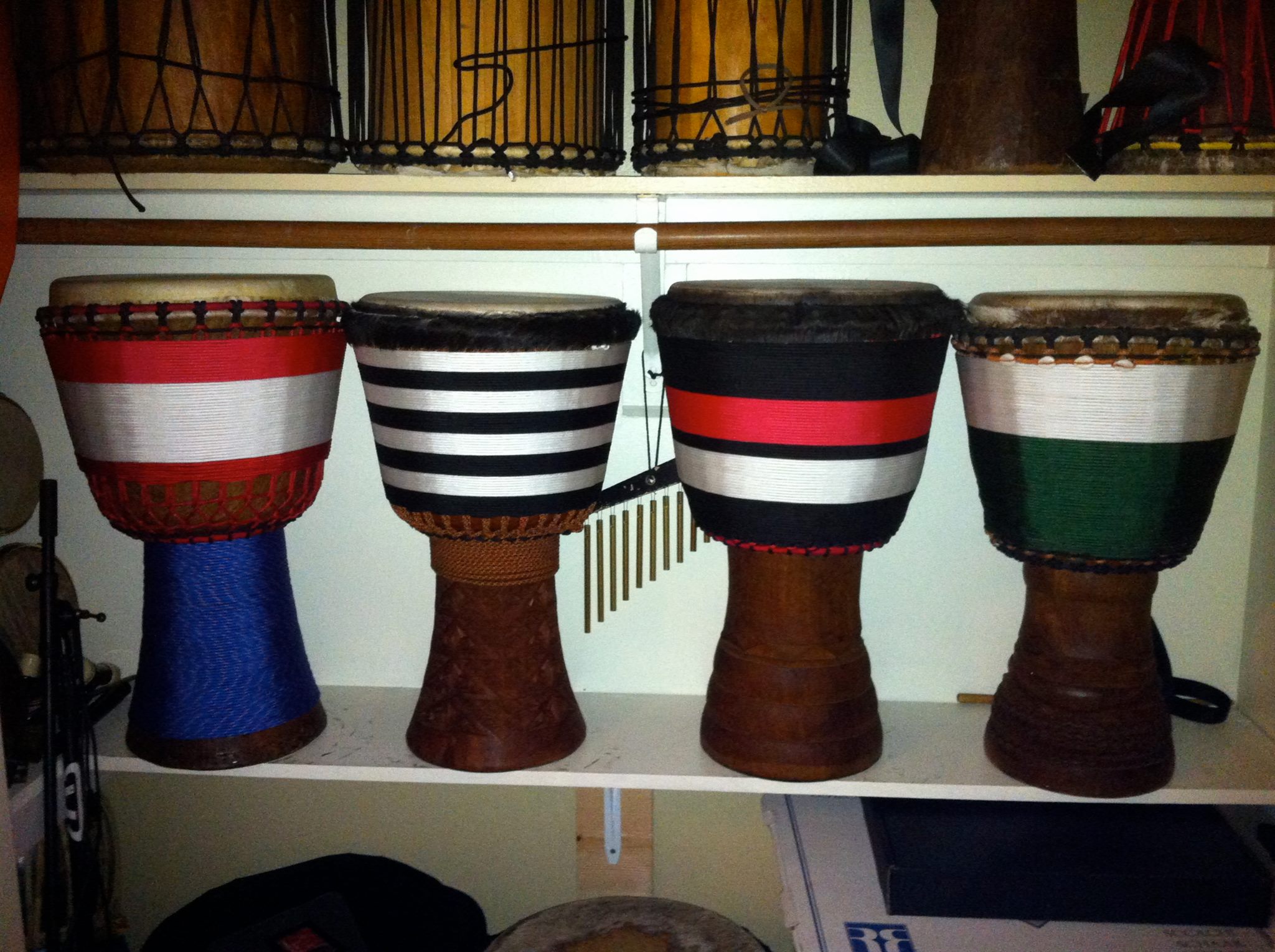
If I did not mention your company, your friend, your drum it is only because I have not had any direct or personal experience with them.
Please do not be insulted or angry if there are simply too many for me to know or have had experience with. The point is for you to find out and explore who is best for your needs.
It’s now up to you to find and decide who is going to make your next drum. Do your homework. If I did not mention you or your favorite drum builder it’s only because there is only so much room and or I dont have any experience or knowledge about them. I have put photos of several of the independent drum makers whose quality seems to be very high up in this article so you can google search them and check them out further as well.
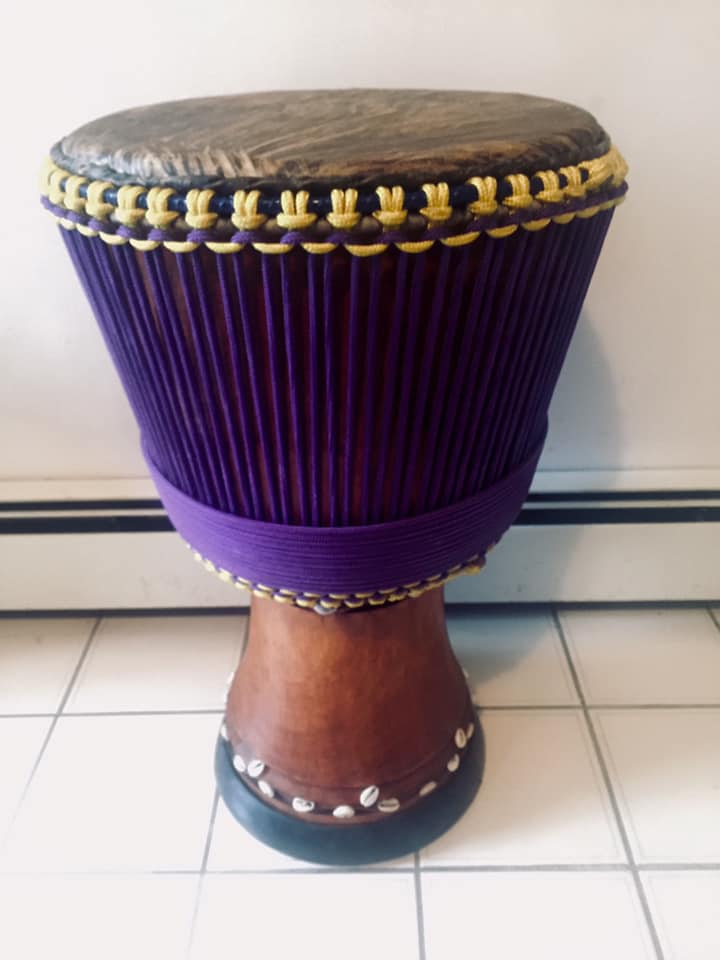
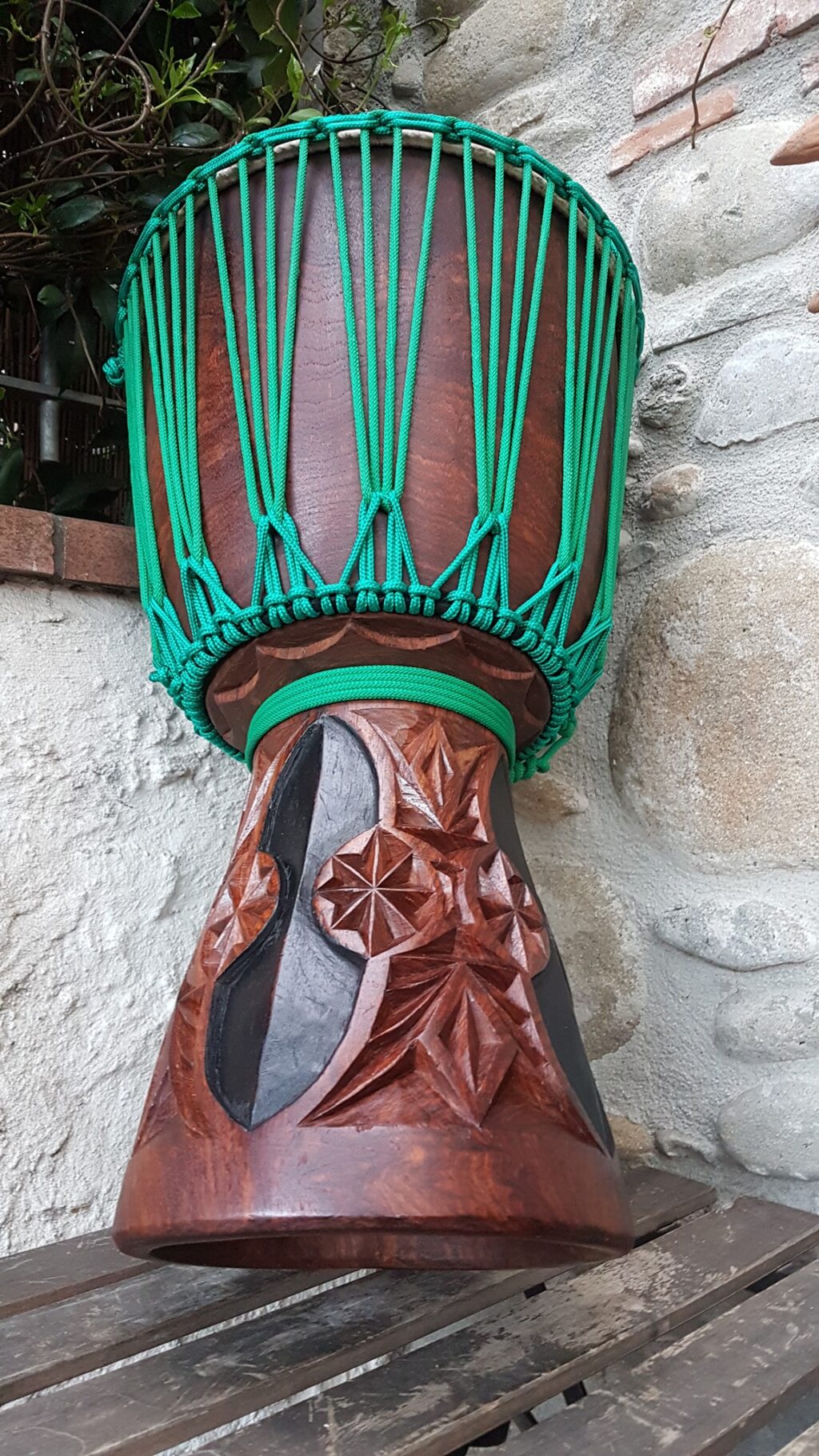
If you don’t have the funds for a really nice drum, you can often find one used on Facebook in the Congas And Djembes For Sale Facebook group.
There are also builders like Dan Cheney who somehow sell beautiful drums, hand built for very little compared to everyone else.
Before buying a Remo, Meinl, LP or other mass marketed drum check out some of the builders there on Facebook.
If you have to have or simply want a mechanical tunable drum, check out Manito Percussion. He puts the highest quality stainless steel hardware onto shells from Drumskull or Wula Drum. Wula Drum may also custom make you a drum with hardware from Juancho in NYC.
And Dan Rice from Motherland Music in Southern California also has real West African djembe drums with metal hardware put on as well. They have been doing it for quite some time as a matter of fact.
Take your time, ask around , do your due diligence please and I am sure you will find the drum and drum maker that’s right for you!
There are some really great drums being made out there and now that you have read this article andeducated yourself a bit more I am sure you can see that there is absolutely no reason to buy a Remo or Meinl hybrid drum. It’s up to you to search and find whats right for you.
Just because a drum is made in West Africa does not mean it’s a great drum. Many inferior products are
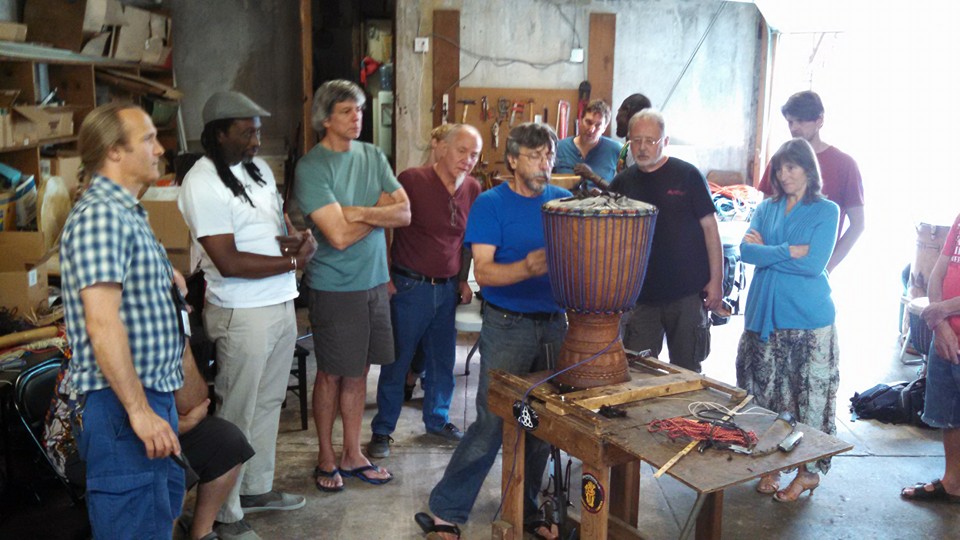
coming out of Ghana made from Tweenaboa wood which as I mentioned earlier in the article I don’t like too much.
The Ghana djembe wood quality has been improving however. There are nice drums on the higher end from Bali these days but the low end cheaper and small drums are not very good so buyer beware.
If you want a lightweight, less expensive wood drum, try a Melina wood djembe from Wula Drum or Drum Skull. Shorty Palmer is also a great resource for inexpensive drums.
Please don’t forget to protect your investment with a heavy duty case. You can get great cases from Djembe Gear Pro. You can find them on Facebook. When you order your case from them the bag comes with a hat, too. If you get one from somewhere else, remember to order a hat.
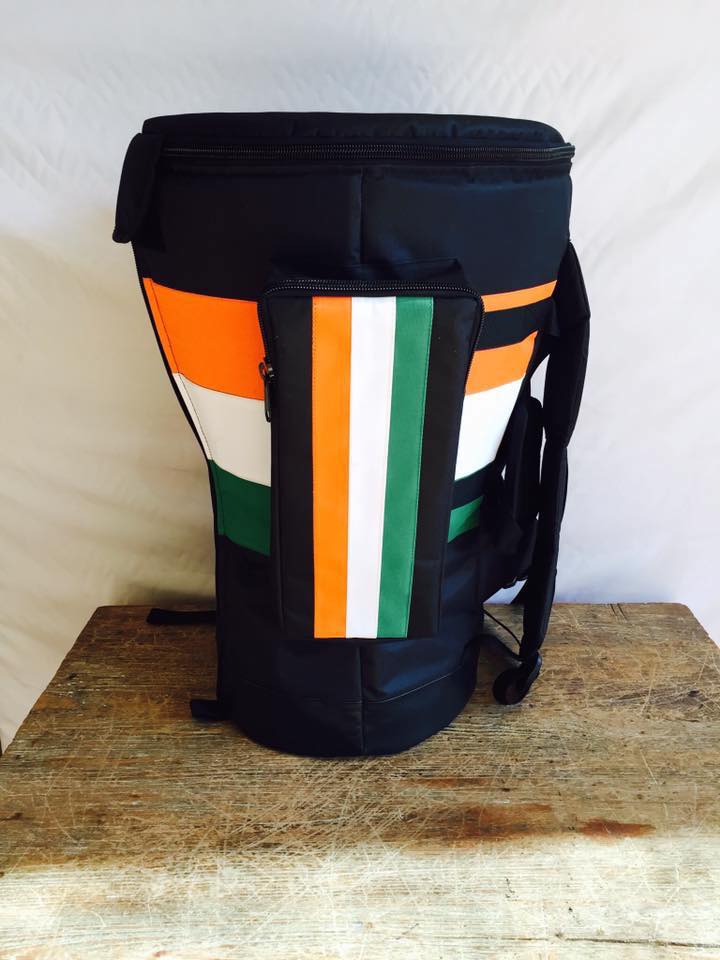
I always have several top of the line djembe drums on hand from my personal collection available for sale as well. I can help you locate a drum used as well .
If you would like to learn more about playing the drum I offer on line classes via Skype or Facebook Messenger.
There is also on line downloadable lessons by me (Michael Pluznick) on this site.
You can contact me here or michaelpluznick@gmail.com
For more info please click on these links:

